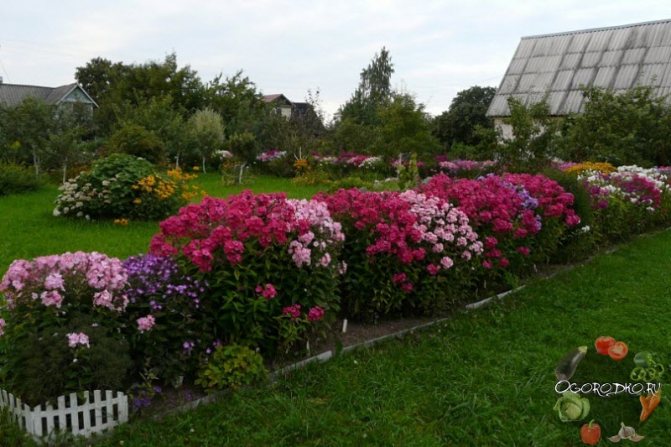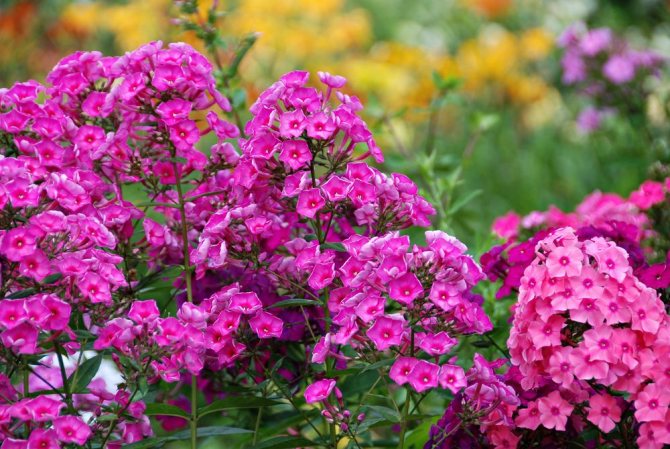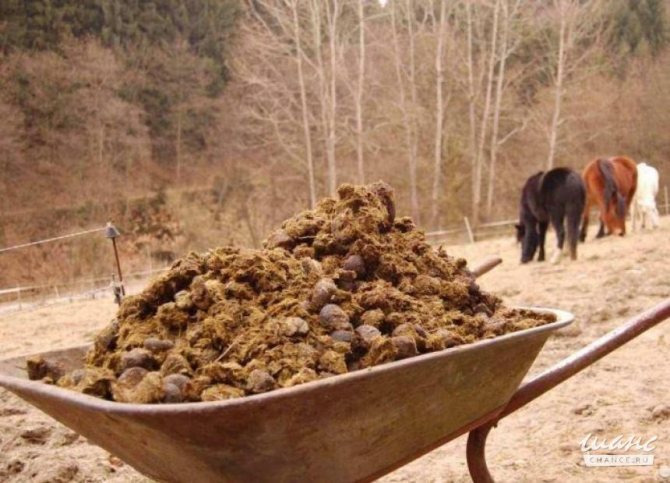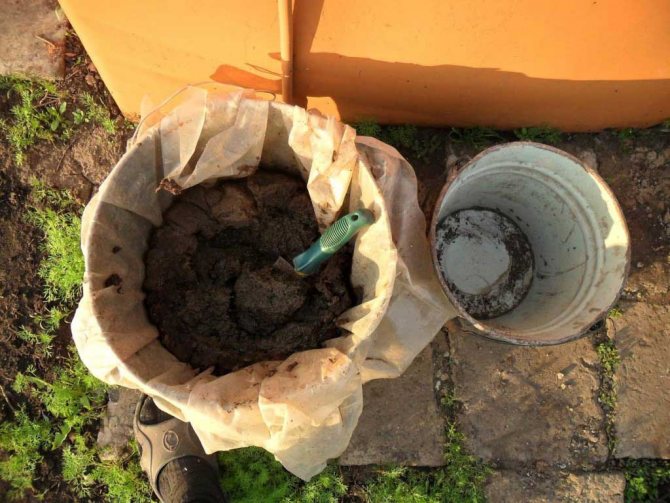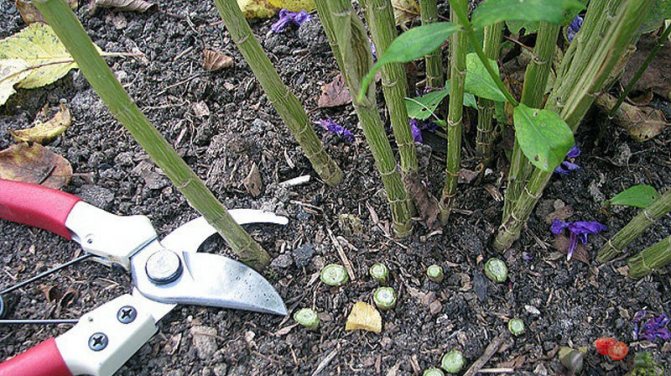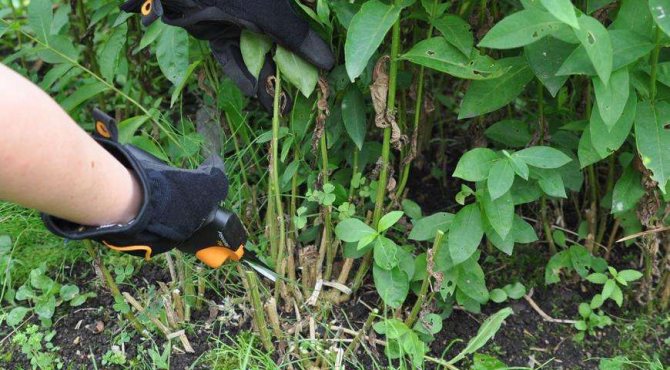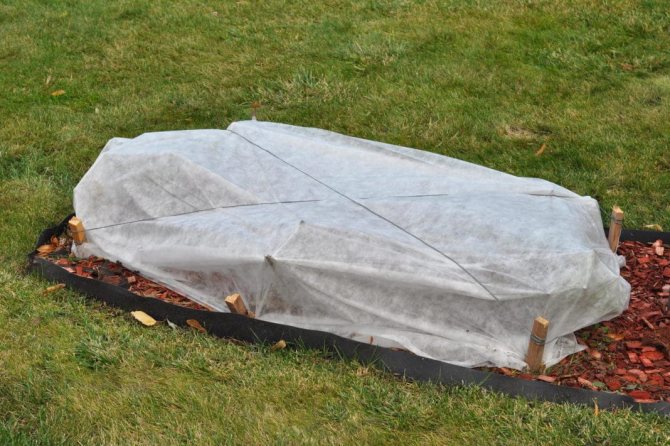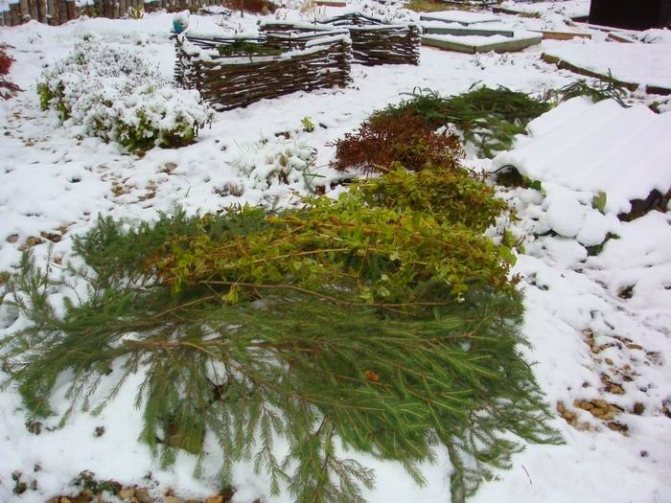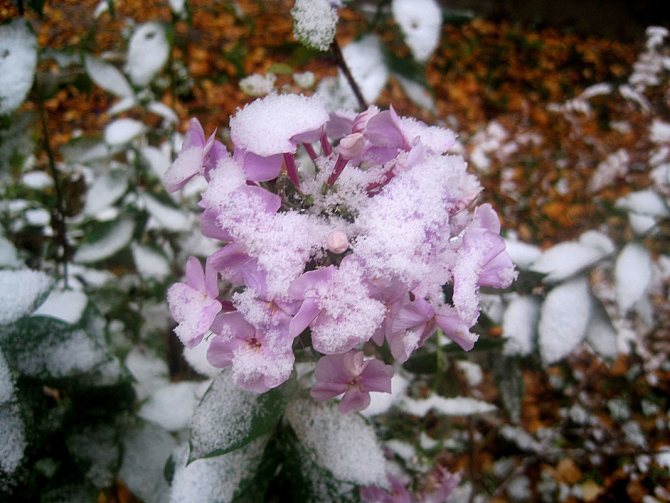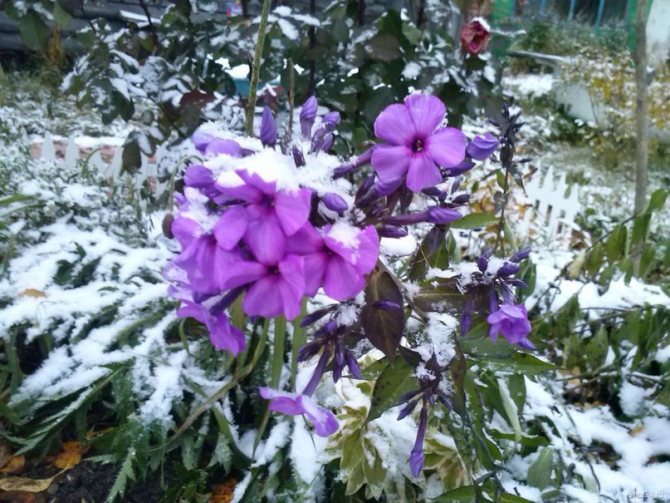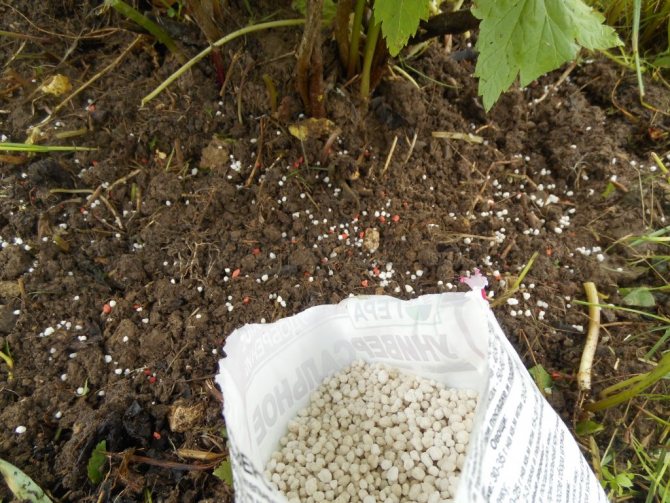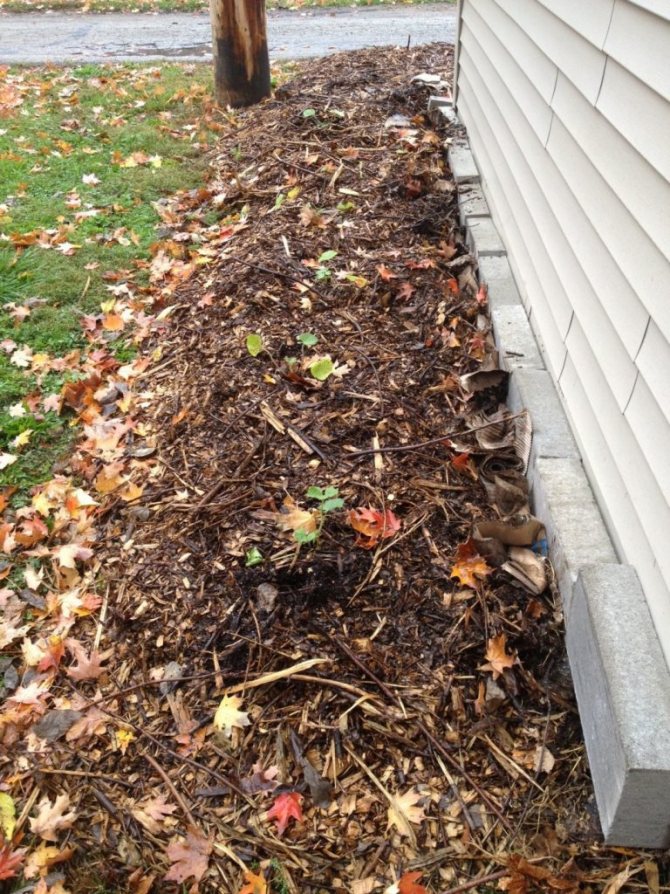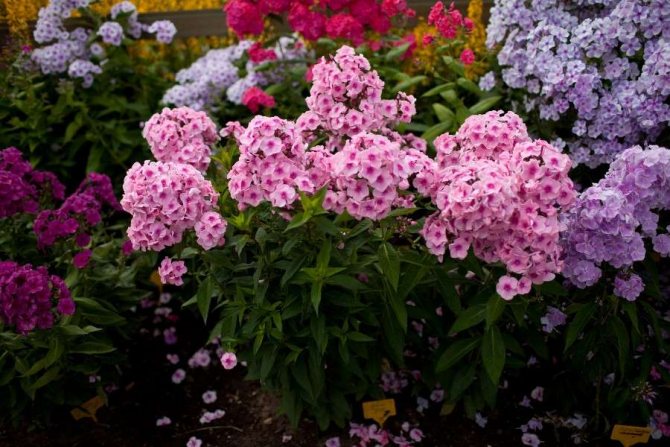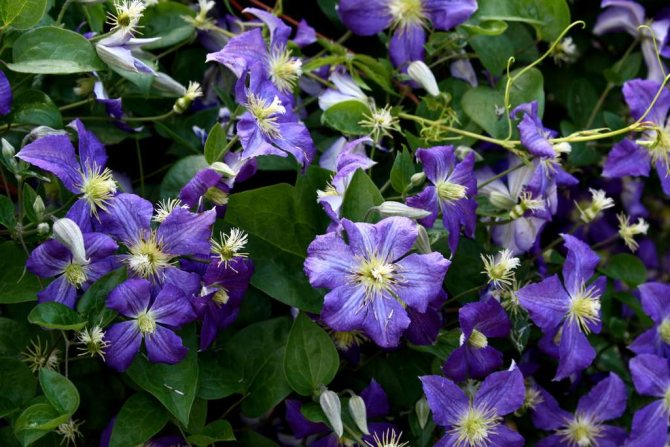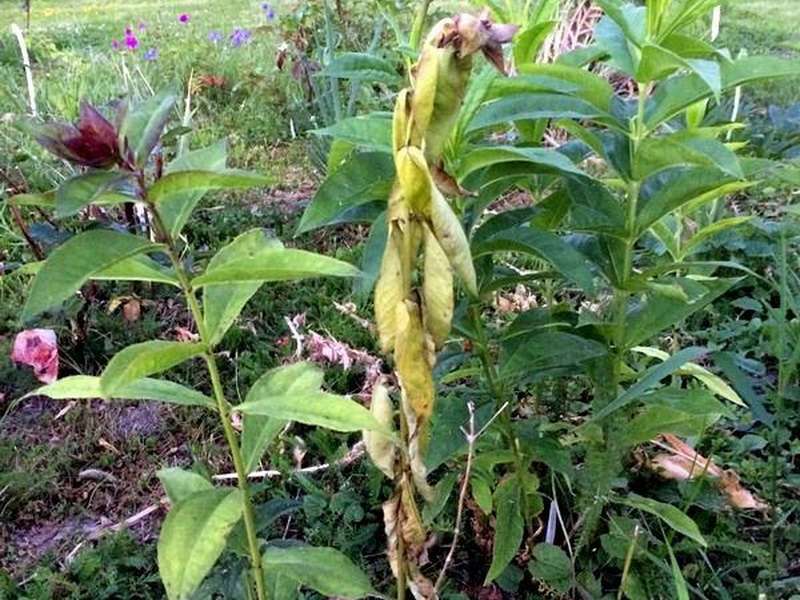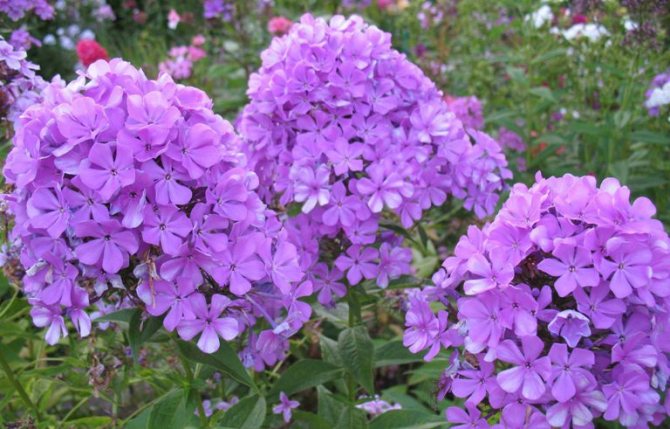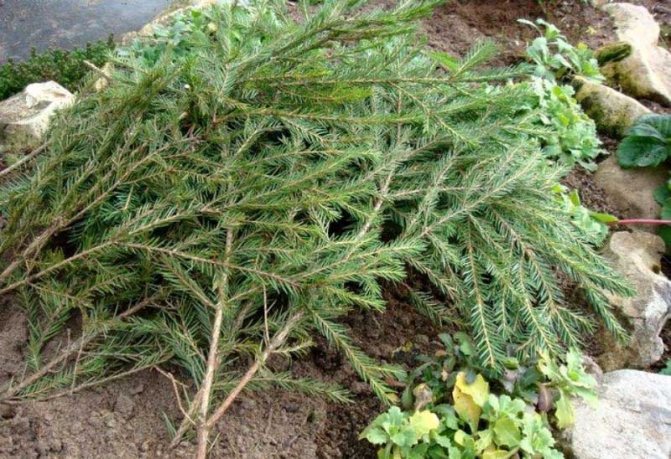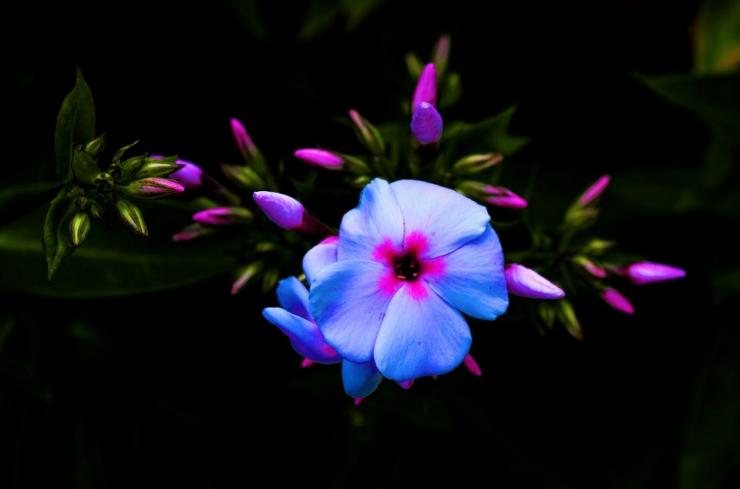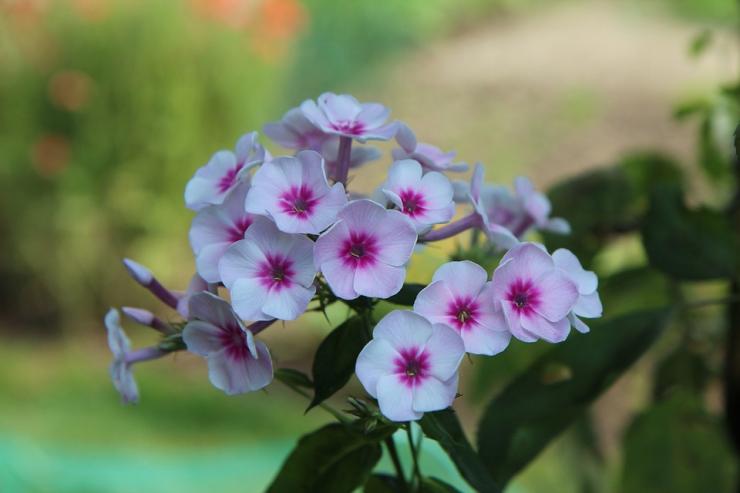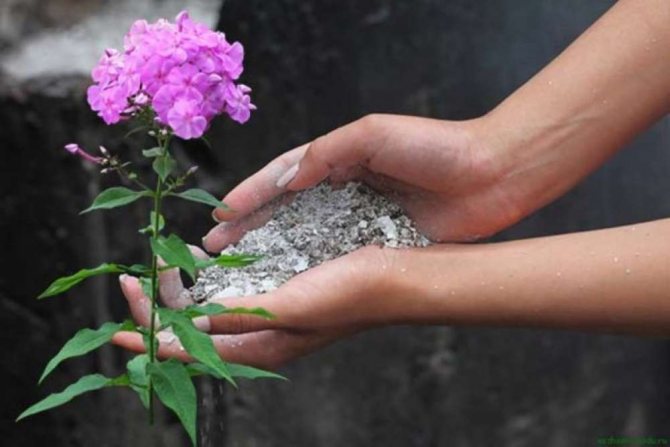Phlox is a vibrant plant whose flowers have a variety of colors. By their nature, they belong to unpretentious crops, but the gardener will receive a fluffy hat of flowers in the next season from proper care in the autumn and observance of wintering rules. Phlox wintering takes place in different ways depending on the latitudes of growth, maintaining the health of the plant in winter in the middle lane is less problematic, while gardeners from the Urals may face some difficulties. How to provide care for phlox in the fall after flowering and whether it is necessary to cover them for the winter, the answers to these questions depend on the localization of growth.
Autumn events for florists

Autumn is no less busy season for a gardener than spring, you need to work hard to maintain the health of all crops in the garden and avoid freezing. Phlox care in the fall includes:
- If the autumn is dry, the bushes need to be constantly watered at the rate of 2 buckets per 1 square meter of planting. Watering is carried out in cloudy weather, in the evening, avoiding the ingress of liquid on the stems and leaves of the plant. It is better to use a watering can with a long spout - excess moisture will lead to rotting of the bush.
- To get abundant flowering in the next summer season, you need to feed the phlox in the fall. For this, phosphate-potassium fertilizers are used. Before fertilizing, the soil must be shed, the roots of the plant are sensitive, therefore, feeding into dry soil is unacceptable.
- To avoid damage to the culture by pests, it is necessary to add some ash under the bush.
- Before covering phloxes, the soil must be well loosened. Gardeners need to remember that the roots are on the surface, so you need to proceed carefully.
- Mulching the soil will help preserve phlox in winter. Compliance with this rule is necessary because the roots of the plant lie on the surface and often come out of the soil. Even in central Russia, soil freezing can be traced, without snow cover - it is detrimental to culture. Peat, compost, manure can be used as mulch.
- It is necessary to cut phloxes for the winter to avoid damage by diseases and pests. Florists recommend leaving a stump from 2 to 20 cm long. Pruning is carried out one month after flowering.
The described rules are general recommendations to ensure the safety of the perennial plant, its health and lush flowering in the next season.
Why pruning in the fall
Before proceeding to the description of the technology, it is necessary to figure out whether it is necessary to cut phloxes for the winter and why to do it.


Many growers advise pruning phlox before winter.
Experts identify the following reasons for these manipulations:
- Prevention of fungal diseases and attacks of insect pests. During the entire warm season, many microorganisms accumulate on the shoots of plants, and if the stems of phlox exceed 20 cm in length, insects may well settle on them for wintering.
- Improvement of culture. Since it is recommended to treat phlox with preparations and fertilizers in autumn, as well as mulch the soil, it will be much easier to do this if you remove excess shoots.
- Preservation of the decorative appearance of the flower bed. With the onset of spring, new shoots will appear on phlox, and if you cut them off before the cold weather, nothing will interfere with the growth of leaves and stems.
- The accumulation of nutrients. The fewer stems and leaves remain on the surface, the more trace elements necessary for healthy growth in the warm season, the roots of the plant will be able to accumulate over the winter.
- Root protection. It is much easier to keep warm and shelter the underground part of the bush from the cold if you cut it off for the winter.
So, it is necessary to trim phloxes, but in order to do everything right, you need to familiarize yourself with the technology of the work.
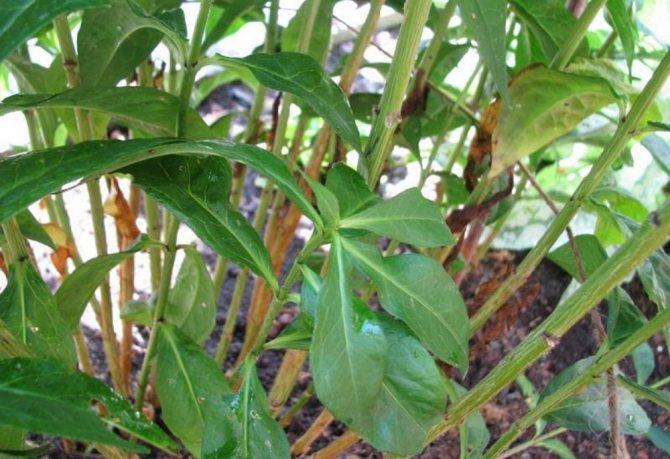

Pests can hibernate on the leaves and stems of phlox, so pruning is mandatory.
Is it possible to plant phlox in the fall
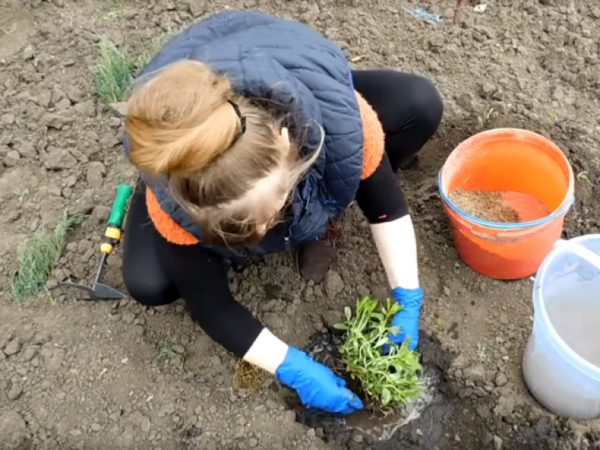

Phlox is an unpretentious culture, which can be transplanted not only in spring and summer, but also in autumn. If you provide full care after manipulation, the plant will tolerate it well. Some growers, on the contrary, recommend abandoning planting on hot days and waiting for autumn - this way the plant tolerates the process more easily and blooms in full the next season, transplanted in spring often get sick during the summer and then develop worse. In the summer, you can only transplant the plant if necessary.
It is necessary to prepare transplanted phloxes for winter in the same way as established crops. Be sure to arrange soil mulching, fertilizer, if a transplant is carried out, should not be applied - the chemical composition can damage the root system.
In regions characterized by the early onset of cold weather, it is recommended to grow early varieties. They complete their flowering early, which allows for a successful transplant. If it is impossible to carry out the operation in the fall, it is better to transplant the flower in the spring.
Dates of planting phlox in the fall
You can plant a plant in the fall before the onset of cold weather and the arrival of night frosts. It is better to transplant in 1-2 weeks after flowering - during this time, the necessary nutrients accumulate in the plant stems. Before planting phlox, it is pruned. This condition is necessary for better rooting. Large shoots are cut, leaving no more than 20 cm, if the plant is young when cut, no more than 5 cm remains. Mulching of the soil is necessary, because the roots are not adapted to winter cold and quickly die after winter freezing.
Choosing planting material
In autumn, it is better to transplant large cuttings, because they tolerate frosts more easily and take root well. It is also necessary to ensure the transshipment of flowers grown in summer from spring cuttings. The planted plot should have at least two stems, they are cut off, leaving hemp with a height of up to 20 cm, at the base of the hemp there should be buds.
It is advisable to dig up the plant without damaging the earthy coma. In this case, adaptation to new conditions will be as simple as possible. The crown with the inflorescence is removed from such plants and 4-8 healthy leaves are left for nutrition.
How to choose a landing site


A couple of weeks before transplanting the plant, you need to start preparing the soil. It needs to be cleaned of herbs and debris. If the soil is clay, you need to add sand. Because phlox grows in fertile loamy areas. If the post is sandy, it is worth adding a little black soil or clay.
After normalizing the composition of the soil, lime, ash and fertilizers are added. They dig up a layer of soil to a sufficient depth - at least 30 cm, because the root system of the plant in the first years after planting actively grows in depth.
For landing, you need to prepare a hole of good width and depth. The roots in it should fit freely.
Terms of planting and transplanting phlox
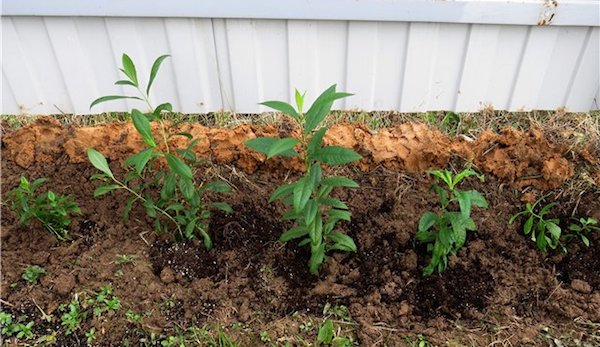

So, the gardener has decided on the time of phlox transplantation, now it is necessary to set suitable work dates.There is no exact date when to plant phlox in open ground in the fall - it all depends on the climate of the area and other factors.
For example, many gardeners are guided by favorable dates from the lunar calendar when working with plants.
According to the lunar calendar 2018-2019
When to plant phlox in open ground in the fall according to the Lunar calendar:
- September - from 1 to 6 (until 5 pm), 8, from 10 to 19, 23 and 24, from 26 to 30;
- October - from 1 to 3, 7 and 8, from 10 to 16, from 20 to 23, from 25 to 30;
- November - from 3 to 6, from 8 to 12.
In the spring of 2019, favorable days for planting and transplanting plants:
- April - 2 and 3, 7 and 8, 20 and 21, from 24 to 26, 29 and 30;
- May - 1, 4 and 5, 17 and 18, from 21 to 23, from 26 to 28, 31.
On the dates indicated, flowers and other plants are easier to transplant and get sick less.
Depending on the region
In order for the perennial to take root after planting and not die with the arrival of winter, the earth should not freeze for another 1.5 months. Based on this requirement, the gardener determines the date of planting in his area.
Facilitates the process of keeping a weather diary, which annually records the timing of the onset of frosts, thaws and other phenomena that affect the life of plants.
In the Middle lane and the Moscow region, phloxes are planted throughout September. If the planting is carried out at the end of the month and soon there is a promise of frosts on the soil, the bushes are mulched with a layer of peat, sawdust or fallen leaves to keep warm.
In the spring, it is necessary to remove the mulch on time so that it does not interfere with the perennial seedlings, and they do not get stuck.
In the Leningrad Region, it is recommended to plant perennials in the first three weeks of September. In the damp climate of the region, it is recommended to pay special attention to soil drainage in the area with phlox.
The Urals and Siberia are a harsh land with a short autumn and an early arrival of cold weather. Perennial flowers are placed here in the ground in late August - early September. Late disembarkation is ineffective. Planting phlox in the spring can give the best results for plant engraftment.
In the south of the country, autumn is warm until November and even December. Phlox can be planted throughout October. It is not necessary to insulate the plant.
In Ukraine, the climate is mild, similar to the Russian south. Flowers are planted at the end of September - October.
In Belarus, phlox is recommended to be planted in the second half of September, focusing on the weather.
Preparing phlox for winter
Like other perennial plants, phloxes, after the onset of cold weather, lose their green mass and die off until spring. To prevent rotting of the entire shrub, gardeners should remember the need for autumn pruning. The process of preparing for wintering, you need to start depending on the variety, therefore, pruning phlox after flowering is in August-September.
How to properly prepare phlox for winter depends on the growing region and the plant variety itself. Older phlox species are used to harsh winters. Therefore, they can survive the cold and little snow winter even without shelter, but the risk of losing part of the seedlings is present. The new varieties are not adapted for growing in cold conditions, because they were bred by breeders in greenhouse conditions or in regions with mild climates.
What time is pruned for the winter
It is impossible to unequivocally answer the question of at what time phlox should be cut for the winter. The reason is that the right moment depends on the variety of flowers and the climatic conditions of the area in which they grow.
There are different types of this culture, which can be conditionally subdivided into two groups: creeping and tall. Both categories require mandatory pruning after flowering, however, carried out earlier than necessary, or, conversely, with a delay, such a procedure will harm the plant.
If the ground part is harvested too early, the leaves will begin to regrow, which will weaken the planting, as a result of which the crop will endure the winter worse.And if this is not done before the first frost, and the soil has time to freeze before the snow falls, the flower bed will die.
So how do you choose the right time to prune phlox? It is worth focusing on the timing of flowering. If this process ends in August, then you can start working in early or mid September.
On a note. In regions where very little snow falls in winter, experts recommend pruning plants not in autumn, but at the very beginning of spring. In the colder months, you just need to throw snow at the bushes.
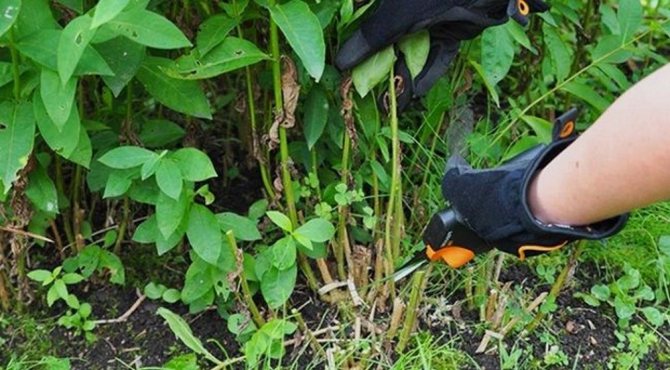

In order to understand when to cut phlox, you need to remember when the plant has finished blooming.
What are the features of preparing a plant for winter in different regions
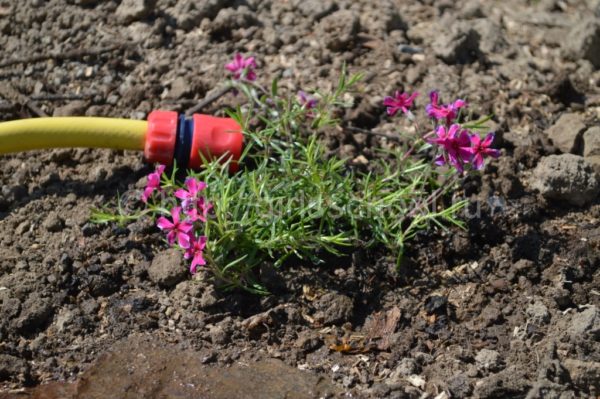

The seriousness and necessity of erecting massive sheltering structures is considered depending on the growing conditions of the plant. In regions with mild climates, shelter, on the other hand, can harm the plant. Due to excessive heat, it can wake up early and damage young shoots during frost. This condition explains the need for a private approach to the issue of sheltering phlox for the winter. Depending on the regions, the recommendations are:
- In the middle lane, for example, in the Moscow region and the Moscow region, the climate cannot be called harsh, because phlox winter well after pruning shoots to a depth of 2-5 cm. To avoid freezing of the roots, it is recommended to arrange mulch.
- For the Volga region, the recommendations are changing, pruning is carried out according to the same scheme, but it is recommended to cover the mulch with tops or branches.
- In the Urals, phlox should be cut off, leaving a stump of about 8-10 cm, the mulch should be covered with tops and branches, and during the winter it is important to insulate the plant with snow.
- It is difficult to care for phlox in winter in Siberia. Because of the fierce winters, the plant is not cut off, mulch is laid, and the top is insulated with branches and foliage.
Soil mulching
Experienced florists recommend mulching phlox for the winter. Especially, this applies to the regions of central Russia, the Urals, Siberia. When mulching and the height of the snowdrifts is half a meter, phloxes can easily overwinter if the air temperature does not fall below - 25 degrees. But in the Moscow region, severe frosts also occur, and winters without snow. In this case, most varieties of foreign selection may die.
You may be interested in: How to insulate a pear for the winter, practical recommendations
It is worth considering that the root system of the bush grows in a peculiar way. The stem stretches horizontally underground. Later, the stem becomes hard, it puts out young roots, and growth buds appear above the roots in the fall. Gradually, the rhizome grows by several centimeters, and begins to bulge out of the ground. Such plants are weakened and may die in winter. Annual mulching can protect the bush and delay the aging process.
The best mulch for phlox is compost, peat, or decayed leaves. Its layer depends on the age of the bush, but should be at least 10 centimeters.
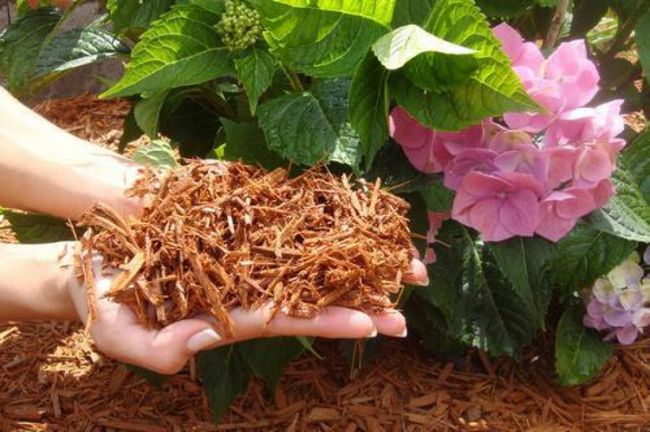

Pruning phlox in the fall
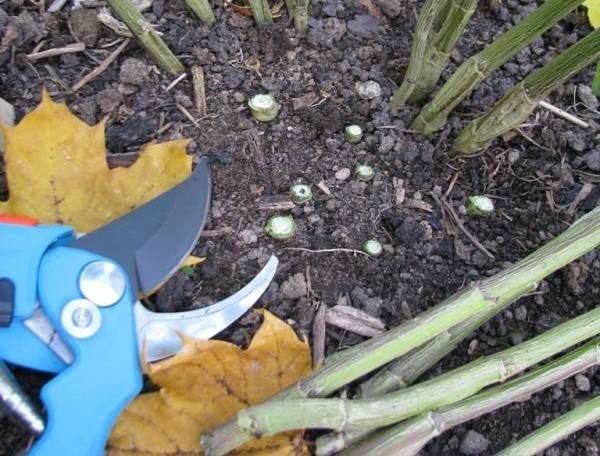

The opinion of flower growers regarding the issue of pruning in the fall differs. Some believe that pruning will help to survive the winter safely. While others say that this is real stress before the cold weather. There is no mistaken opinion here. You can trim phloxes in the middle lane and in the Volga region; you should not prune before winter in Siberia and the Urals. In this case, the operation is carried out in the spring, under the influence of sunlight, the phlox will quickly grow and form a lush bush.
Why pruning in the fall
The main goals when pruning a plant:
- prevention of fungal infections in the next season;
- when pruning the stem, pests parasitizing on the green part of the plant are removed;
- ensuring the transition of nutrients after flowering to the root system;
- after pruning, it is easier to equip the mulch to carry out top dressing.
Phloxes are pruned for the winter to get a lush bush in the season.
How to prune phlox
Pruning phlox for the winter is carried out according to one of 3 schemes:
- The unearthly part of the plant is removed at a height of up to 2 centimeters above ground level. This makes it possible to exclude damage to the crop by pests that have accumulated on the crop during the season.
- The stems are removed, leaving branches up to 10 cm long. This contributes to the formation of a large bush in spring from young buds.
- After pruning, stems up to 20 cm long are left. This method has a significant drawback - pathogens remain on the stems of the plant, phlox cut according to this scheme is difficult to mulch.
Scheme number 1 is acceptable. Experience shows that phlox cut according to scheme 2 do not develop well and do not bloom profusely, and pruning according to scheme 3 is dangerous for fungi and bacteria.
What time is pruned for the winter
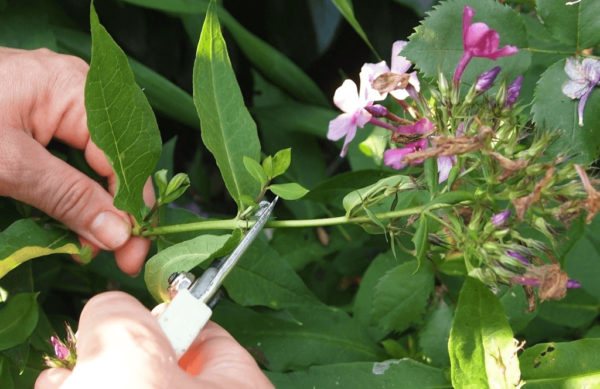

The pruning time is determined depending on the cultivated variety. Early flowering phlox is pruned in early September, and late plants are cut in October, a few weeks after the flowers have been completely removed.
What to do after pruning
Just pruning the plant is not enough for the action to be beneficial, the culture needs to be provided with the necessary care, namely:
- the garbage remaining after trimming is burned away from the personal plot or disposed of in another convenient way;
- the soil around the plant is treated with fungicides before mulching;
- before the plant is covered, it is fed in a few days, bringing superphosphate under each bush.
It is better to replant phlox after flowering, because planting in spring will prevent the plant from gaining strength by summer.
What to do after pruning
After the phlox trimming is completed, some more manipulations will be required, namely:
- After pruning, phloxes must be mulched.
Top dressing. With the arrival of the first cold weather, you need to lay ash and a tablespoon of mineral fertilizers under the bush. This will help support the plant and repel parasitic insects.
- Mulching. This should be done 10 days after pruning, using humus, fallen leaves, rotted compost or peat. This procedure is repeated with the onset of spring, which allows the phlox to be provided with additional nutrition.
If done correctly, the culture will perfectly endure the winter, and in the summer months it will delight the gardener with healthy growth and abundant flowering.
Fertilization
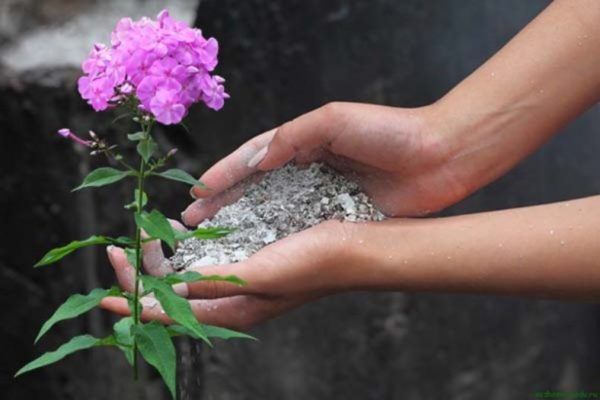

Before applying top dressing, you need to treat the soil and phlox with drugs such as Fitosporin or Fundazol. The above-ground part of the plant is treated with these preparations and the soil is shed on a dry, moderately sunny day. Such products will help reduce the risk of fungal and bacterial damage. Processing is carried out in spring or autumn.
Superphosphate is introduced into the soil no earlier than two weeks later. Such fertilization will saturate the soil with phosphorus and potassium - these nutrients will enter the roots during the winter. What to increase their survival rate.
When purchasing ready-made fertilizers for flowering crops in open ground, it is better to buy a composition labeled about. The use of formulations with a high content of these components can provoke rapid growth before wintering, which will cause the death of the culture.
Disease prevention and protection against phlox pests
The following rules will help keep the plant healthy:
- regular loosening of the soil in spring and autumn;
- transplanting a flower to a new place once every 3-4 years;
- harvesting weeds and fallen leaves from the front garden - it is a source of fungal and bacterial lesions;
- soil treatment with peroxide;
- use of fungicides.
The listed rules will help to preserve the collection.
Attention!
The plant is hard to bear any disease, the danger lies in the fact that at an early stage no signs of damage are visible.You need to pay close attention to signs such as leaf curl, discoloration, or falling off.
Watering phlox in autumn
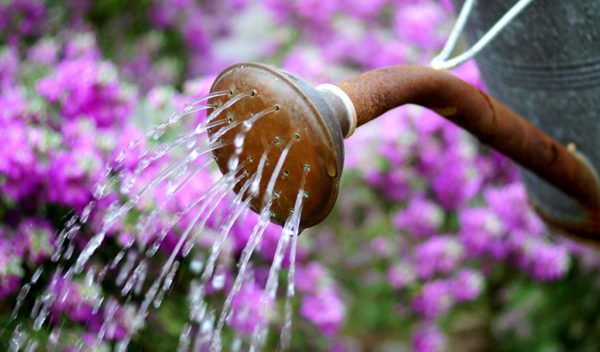

If there is no rain in the fall, phloxes need to be additionally watered, because sufficient moisture is a condition for full wintering. It is worth watering the plant carefully, because its root system is vulnerable and is often affected by a variety of bacteria and fungi. It is better to water phlox with water at room temperature, you need to avoid getting moisture on the leaves and stems - this can provoke rotting.
Care rules
Phlox is relatively easy to care for, making it great for the inexperienced gardener. It is enough to water them in a timely manner, season them, remove weeds and make sure that the water does not stagnate, loosen them if necessary. The most classic set of flower care activities. Sometimes, if the flower bed is too thick, you can transplant.
Watering
Watering is carried out regularly twice a week (depending on the weather) in the morning or in the evening. For irrigation, it is recommended to use water at room temperature or warmer - cold water, especially in hot weather, can give a temperature drop, due to which the stems crack.
The abundance of water for one irrigation is calculated from an approximate ratio of 15 liters per square meter of land. But, this is a theory, but in practice it is necessary to maintain the golden mean and prevent stagnation of water. Experienced gardeners can use mulching to easily adjust the moisture content of the topsoil.
Loosening and weeding
Weed as needed. But it is necessary to loosen at least six times a season - this improves the permeability of the soil. To save time and effort, weeding and loosening can be combined. It is necessary to loosen carefully, the upper few centimeters of the soil. Along with this, you can mulch using hay or sawdust for this. If the soil has already been flavored with organic matter, then the use of compost and humus is not recommended - this will increase the abundance of greenery and worsen flowering.
Top dressing and fertilizers
It is necessary to feed phloxes several times per season: - The first time fertilizers are applied to the soil shortly after transplanting, when buds begin to form. Usually this is the end of May, beginning of June. Organic fertilizers are used for this - a mullein solution in a ratio of 25 g per 10 liters of water is well suited. - The next time you can season the soil in a couple of weeks, somewhere in the middle of June. Use superphosphate and potassium salt for this. - From the beginning of active flowering, plants are fed with potassium salt or liquid manure. - In cold climates, fertilizers are added before winter. For this, compost and humus are used.
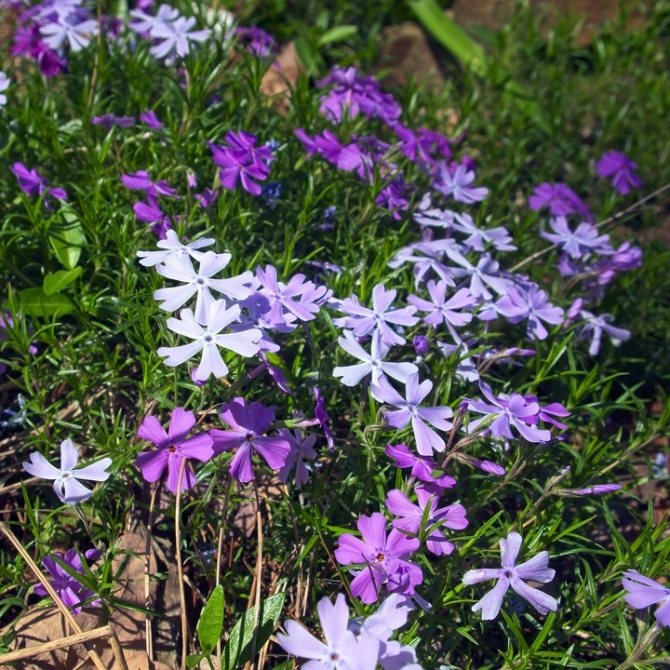

Shelter for the winter
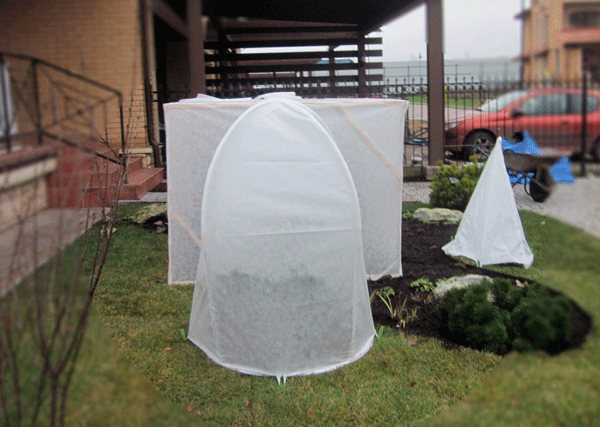

Phlox is a frost-resistant crop that can withstand a mild winter without any shelter, but since there are periods of cold even in warm winters, you should not risk a collection of chic plants. For the aboveground part, the danger is a drop in temperature to -15 degrees, for the underground to -20. For the plant, not only severe frosts are dangerous, but also long thaws, leading to the loss of the snow layer.
For shelter, natural materials are used. It is forbidden to use film, linoleum and other materials for this purpose - the plant under them will suffocate. The shelter is removed after the risks of severe frost in the spring are eliminated.
Wintering
Preparing for winter will not take much of your time. The stems are cut so that no more than 15cm remains. All leaves and other plant residues must be carefully collected - they can become a breeding ground for pathogenic fungi. The rest of the stem is wrapped with agrofibre or burlap - several small holes are made in the fabric for ventilation. The ground around the stems is covered with straw or sawdust.
Like it if you liked the article, and write your additions for other gardeners in the comments.
Typical mistakes in phlox care in autumn and in preparation for winter: we care correctly
The list of major mistakes includes:
- The use of nitrogen fertilizers in the fall. A large dose of the component accelerates the formation of new shoots and enhances their growth, the roots lose nutrients and weaken. Because of this, the plant often dies during wintering.
- The plant was early "sealed" for the winter. If warming is still possible, the culture should not be insulated.
- The perennial is covered with dense cellophane, cloth or airtight elements. As a result, the plant dies due to rot.
It is necessary to avoid such mistakes, because they often lead to the death of culture.
Description of the flower
Phlox flowers are annual and perennial ornamental herbaceous plants of the Sinyukhovye family. They come from North America - it is believed that due to this they are highly resistant to disease and cold. There are as many as 70 species in the genus, of which only 20 are subject to cultivation and selection.
From the Greek language "phlox" is translated as "flame". This name was given to the plant by Karl Liney himself, presumably because of the bright inflorescences.
The appearance of plants varies greatly from species to species. Among them there are both semi-shrubs and erect bushes. Some are of color in spring, others in summer and even autumn. Some species look more like moss than flowers. Among the whole family, you can find very little ones about 20 cm in height and mighty giants up to almost two meters high. The shape of the leaves is also very different, and the flowers during the flowering period vary from two to four centimeters in diameter.
Useful tips for caring for phlox after wintering
After the onset of spring, phloxes often have an unattractive appearance, in order to restore it after the lengthening of daylight hours and the formation of a positive temperature at night, they feed the plant with fertilizer - this will accelerate growth and restore the root system. Be sure to remove dry shoots and other parts. If the condition can be called critical, it is worth using growth stimulants - "Epin", "Zircon". This biological composition will help awaken dormant kidneys and accelerate their growth.
What to do if phlox froze in winter?
If for some reason your flowers could not successfully overwinter, then you can try to save them. We recommend saving phlox in the following way: cut out the middle of the bush with a sharp knife, making the edge of the bush 2-4 cm thick.
And fill the middle of the bush with a universal nutrient substrate (fertile soil) and process it with Epin. This method stimulates dormant kidneys and promotes phlox resuscitation.
- We hope this method helps, and phloxes will delight you again!
Pruning phlox
To the question of beginners whether it is necessary to cut phlox after flowering, professionals answer unequivocally - after the flowers dry out, the bushes must be cut off.
Do I need to prune phlox after flowering
Pruning flowering bushes is necessary for:
- Minimizing the risks of contracting a fungal infection. Most spores, viruses and insects hide in dry shoots of plants for the winter.And the lush bushes suit them best. But as soon as the sun warms up, the active development of "gardener's troubles" begins. Pruning the plant in summer will help minimize the risks of infesting the flower bed.
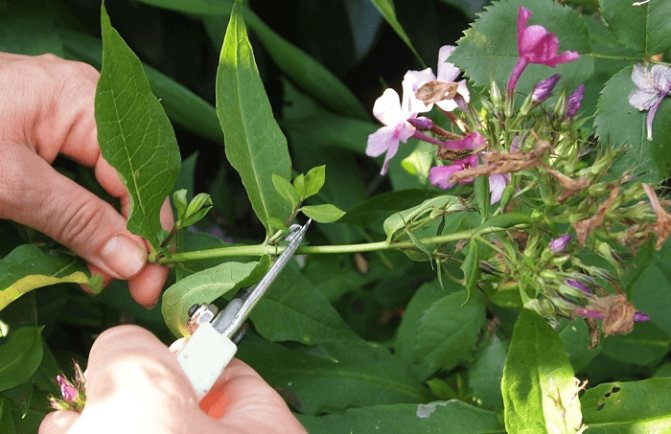

- Hassle-free autumn work: preventive treatment, mulching the surface of the earth in a flower bed, introducing nutrient compositions. Dry stems can be a real challenge when gardening.
- Preservation of the decorativeness of the flower bed at any time of the year. The area with dry phlox branches looks unaesthetic outwardly.
- Filling the root system with strength during dormancy. In winter, the plant does not have to lose nutrients to the dried out bushes of the shoots.
- Preservation of rhizomes in winter. A feature of the roots of phlox is surface occurrence, and dry stems lead to their exposure, which is unacceptable during the frost period.
- Preservation of immunity, which promotes the germination of strong and healthy shoots in the spring.
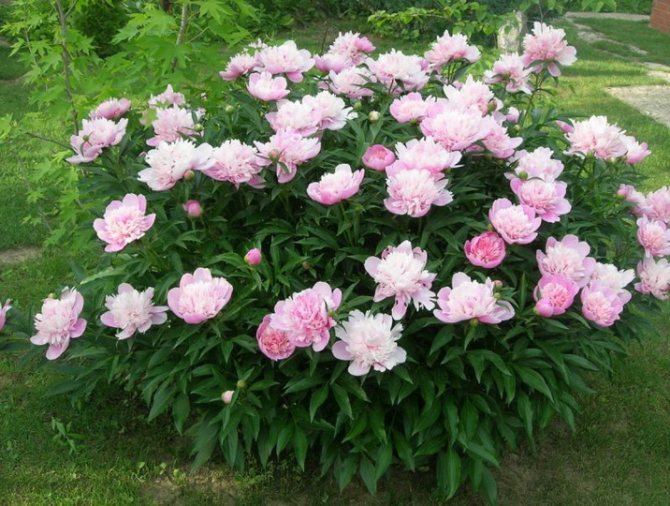

Pruning a flowering plant is not only a decorative procedure, but also an excellent prevention in winter.
Pruning time
Studying the question of when to cut phlox after flowering for the winter, one should be guided by the varietal peculiarity of the plant. Different varieties of flowers bloom at different times, therefore, require an individual approach. In any case, the procedure is carried out after the flowers have dried, as a rule, from September to October.
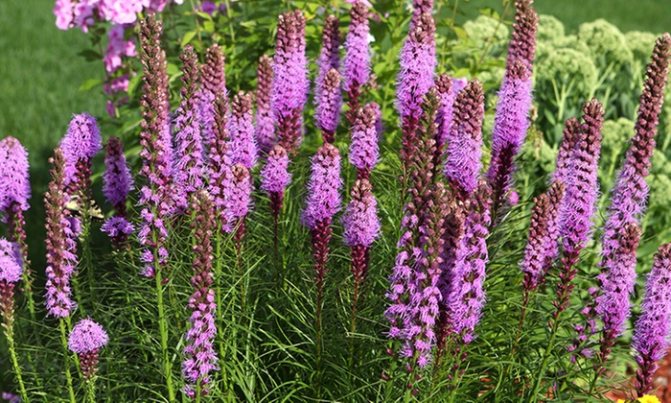

When determining when to prune phloxes in the fall, the climatic characteristics of the region should be considered. The optimal time is when the stems have dried up, the nutrients have accumulated at the root, and the first frosts have begun. But in any case, before the onset of regular frosts, all procedures in the garden are stopped.
Some professional growers recommend pruning dry stems in the spring. This applies to regions with little snowy winters. Experts say the dry stems will collect the snow and thus help it settle over the root.
How to prune phlox correctly
Before studying the process of how to prune phlox after flowering, you should determine the characteristics of the region. If the winters are snowy, it is better to prune phlox in the fall. If the plants are grown in dry climates where there is little snowfall, phloxes are pruned in the spring.
Preparing phlox for winter, pruning time and methods of performing the technique:
Use a pruning shear to cut off all stems at ground level. This method will help prevent the proliferation of pests and infections.
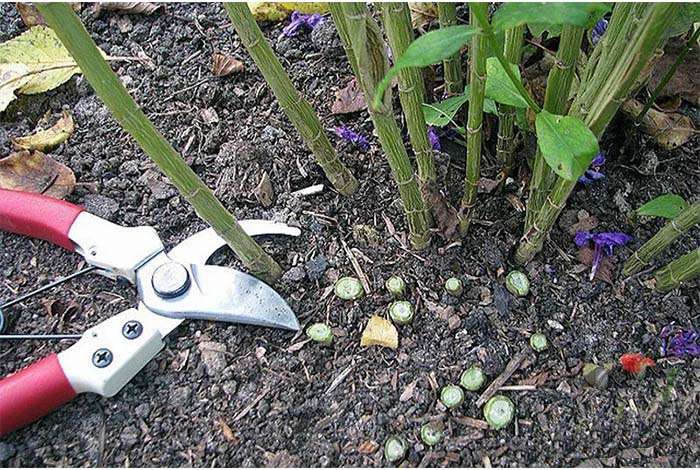

Advice! After the procedure, all dry stems should be removed from the flower bed and burned. The procedure will help remove all pests and fungal spores that have multiplied during the growing season.
After pruning, the soil around the bush is treated with systemic fungicides.
Fertilizing and preparing the plant for wintering
To preserve the variety and prevent possible freezing of the root system, phloxes must be fed in the winter. Nutrient compositions are applied superficially to already frozen soil. Use superphosphate or other complex mineral fertilizer (1 tbsp. L. The drug is crushed in the trunk circle).


Advice! When carrying out the autumn digging of the soil, wood ash is introduced, which will not only fill the plant with nutrients, but also help scare off pests.
Preparing a plant for the winter period also provides for the mulching procedure. It is carried out 7-14 days after cutting the ground part of the plant. Used as mulch:
- Dry slightly acidic soil.
- Perennial humus.
- Dry leaves that are harvested as soon as the snow melts.
Read also Tomato hearts gonsiorovskih reviews
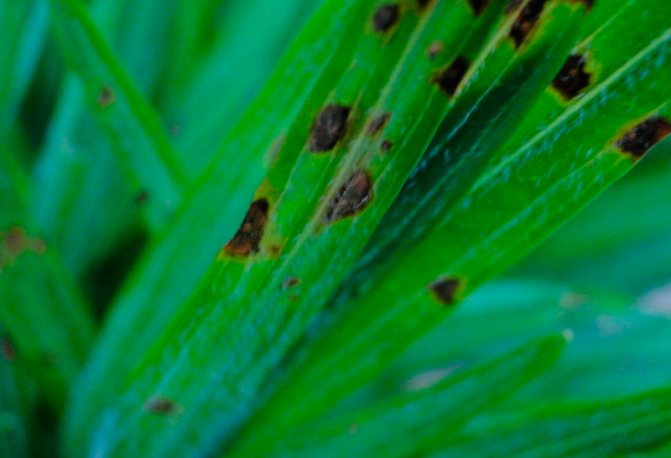

Mulch is laid in a layer of 7-12 cm, and when the risks of spring frosts disappear, it is removed.
Mulching is extremely necessary, since the maintenance mechanism helps not only keep the plant healthy in winter, but also fill it with nutrients in early spring.
Phlox are ornamental plants that delight the eye with graceful caps of flowers of different colors. Having planted them once in the garden, the gardener will be able to admire the refined flowering for a long time in the warm season.
Introducing phlox care in autumn and spring. We will tell you how to prepare phlox for winter: do you need to prune phlox after flowering, when you need to prune phlox for the winter, how to properly prune phlox in autumn.
We also describe phlox care in the spring after winter.
Phlox: planting and care in the open field
Phlox is a light-loving plant, this must be taken into account when planting. But the direct sun is not very pleasant to him, therefore it is best to determine the plant for residence in a place where partial shade is created by bushes and trees in the heat.
Despite being undemanding, flowers grow best in slightly acidic or neutral loose soil. The ideal option is loam. For the best survival rate and lush flowering, organic fertilizers are applied to the planting pit. When planting, the bush descends vertically into it, sprinkled with earth, which is then tamped and watered. Experts recommend leaving a distance of about 0.4 m between plants so that the bush has room to grow. After watering, the soil around the plant is mulched.
Phlox care consists of three operations - watering, loosening and feeding. There should be enough moisture, but not excessive moisture. In the heat, the plant is watered twice - in the morning and in the evening. For this, a watering can is used. It is undesirable to get water on flowers and leaves.
Loosening is carried out when a crust forms on the surface of the soil. It is carried out carefully so as not to damage the roots lying close to the surface. Mulching is also encouraged to retain moisture and inhibit the growth of weeds.
Top dressing is done after watering. It is carried out 5-6 times from May to September. At the same time, both organic fertilizers are introduced - an infusion of manure, wood ash, and mineral fertilizers - ammonium nitrate, potassium salts and superphosphate.
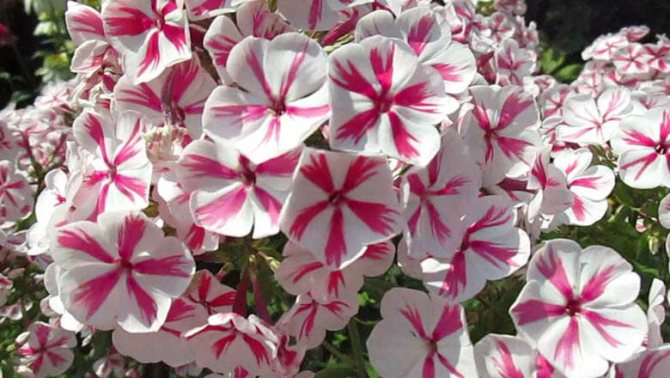

Care steps
It is necessary to start preparing flowers for winter from mid-September to early October, but it is worth focusing on climatic conditions. Once the phloxes have completely bloomed, preparation procedures can be carried out.
Pruning
Phloxes definitely need autumn pruning, despite the fact that some experts recommend pruning them in the spring. This will not only protect flowers from diseases, pests, but also strengthen the root system, rejuvenate the aerial part. The ideal time to prune early varieties is September, while late varieties are in mid-October. The procedure removes all pests that live on green stems from the plant.
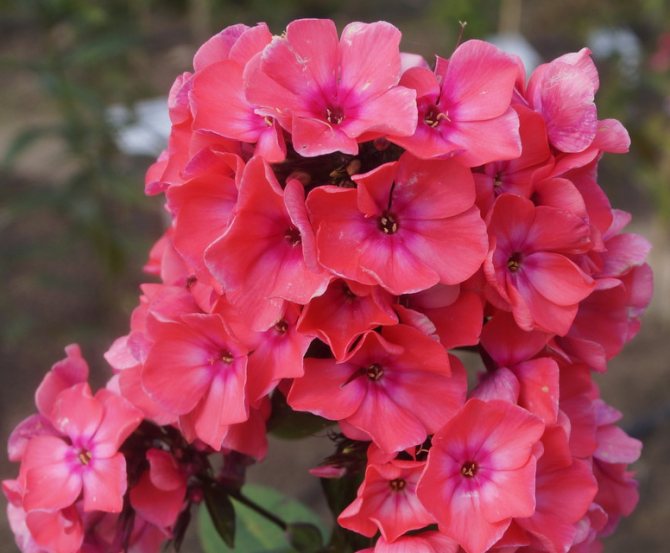

Parts of the bushes that are dying off for the winter must be cut off with a pruner even before the onset of cold weather
There are three ways to carry out the procedure:
Recent Entries
Gardener's lunar calendar for 2020: we do it right 3 reasons, make a reservoir in the country: we plan a new season Note for gardeners: 7 useful things to save energy
- cut off all the stems at a level of 2 cm from the soil;
- the plant is cut, leaving shoots and stems 8 cm long;
- the stems are cut, but high stumps up to 20 cm long are left.
The first method is the most reliable and simplest, it allows you to completely protect the plant from frost, pests and diseases. The second pruning method has not earned popularity, since in spring young stems grow and develop much worse. The third pruning option is very popular both in the southern and northern regions, but there are also disadvantages here: pests winter successfully on the remaining stems, and it is very inconvenient to process and mulch such phlox.
Top dressing
To the usual spring and summer dressings, autumn (pre-winter) must be added. It is necessary for successful wintering and subsequent rapid growth and lush flowering of the plant. Before fertilizing, the soil around the flower is watered abundantly. After a few days, the root soil must be treated with special fungicidal preparations. Such a procedure is carried out in early October, and after 12-14 days, you can make a phosphorus-potassium supplement. Additionally, experts recommend applying fertilizer between the beds and bushes, consisting of 2 parts of superphosphate and 1 part of ash.
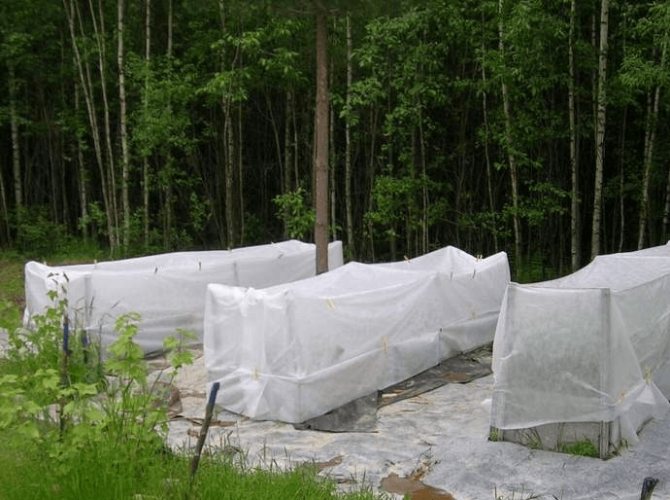

In no case should plastic wrap and roofing material be used to cover phloxes.
Early varieties of phlox can be fed with nitrogen-potassium mixtures, but the nitrogen content in them should be very low.This substance promotes the growth of the green mass and the development of the plant, which is unacceptable in the autumn period.
For late varieties, experienced growers advise using nitrogen-phosphorus fertilizers, but also with a minimum nitrogen content. You can use other ready-made mineral mixtures for root and foliar dressing.
It is better to apply fertilizers in the evening, and liquid dressings work more actively after abundant watering. Dry nutrient mixtures, on the contrary, are used before watering or rain, so that useful components get into the soil. It is important to observe the recommended dosage and consumption rates of dressings, because their excess is no less dangerous for the plant than the lack. Any autumn fertilizers are applied to wet soil and only after pruning.
Shelter
It is important to take into account that the aboveground part of the plant dies already at a temperature of 15 C, and the roots freeze out at 20 C. A prolonged thaw is no less dangerous for phlox, when the buds begin to bloom, the plant revives, and with repeated frosts it dies. To prevent such troubles will help the correct shelter of the culture and mulching the soil with peat or humus.
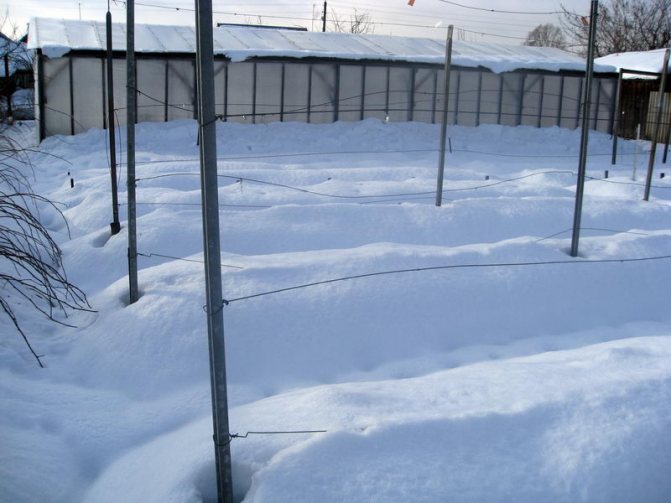

A layer of snow with a thickness of 50 cm reliably protects plants even in 35-degree frost
Proper cover consists of dense and deep mulching of the cut plants. The mulch layer should be at least 10 cm and completely cover the aerial part of the phlox. From above, the plant must be covered with a large amount of spruce branches. In no case should the plantings be covered with a film, roofing material and any material that does not allow air to pass through. This contributes to the appearance of rot and the subsequent death of the plant.
Other procedures
Other mandatory procedures include thorough weeding, loosening, watering, and mulching. Before wintering, the soil around the plants must be rid of weeds and thoroughly loosened. This must be done very carefully so as not to damage the roots of the flower. Dry autumn requires abundant watering (at least 20 liters of water per 1 sq. M). Waterlogging or overdrying of the soil must not be allowed. Water the plants in the early morning or evening, only at the root.
The more thoroughly the pre-winter preparation of phlox was carried out in the fall, the more chances of getting healthy and beautiful plants in the spring. The main needs of these perennials are feeding, pruning and shelter.
Transplanting phloxes in the fall to another place
A few years after planting, the bush takes on an unkempt appearance, the number of flowers decreases, the stems begin to tend to the ground. This is a sure sign that it is time to share it. The procedure is done in early spring or summer, in cool, cloudy weather. But the plant will take root best of all after an autumn transplant. But do not tighten it so that it has time to take root before the frost.
The bush is carefully dug up, the earth is shaken off, but not completely, the roots are untangled and divided into several parts. There are two opinions about the method of dividing: you need to do it only by hand, or you can cut it with a knife / shovel. In any case, the cuttings need to be planted as quickly as possible so that the roots do not dry out - phloxes do not like this very much. When dividing, attention is paid to the presence of large roots, eyes and shoot rudiments in the planting material.
Flowers can be propagated by cuttings. To do this, a branch that has not yet bloomed bends down and sprinkles with an organic mixture. Over the summer, it will take root, and in the fall it is a separate plant, ready for transplantation. In the fall, phlox bushes are transplanted only when cut off.
Landing
Phlox landing. To grow seedlings at home, you first need to prepare the soil. Mix peat, river sand and black soil in equal parts and add some wood ash.
- Choose a seedling box. Check that there are drain holes at the bottom, otherwise make them yourself.
- Prepare potting mix and put it in the box. The depth of the mixture should be about 15cm.
- No seed treatment is required. Just scatter them evenly over the surface of the soil and lightly sprinkle with sand.
- The finished seedlings are watered and covered with a film, put to be stored in a well-lit place at room temperature.
- Air the seedlings every day, but no longer than 20 minutes. Also moisten the soil with a spray bottle.
- With the appearance of the first shoots, the film is removed, and the box can be rearranged to a cooler place.
- A picking is usually not required, and shoots are immediately planted on the site.
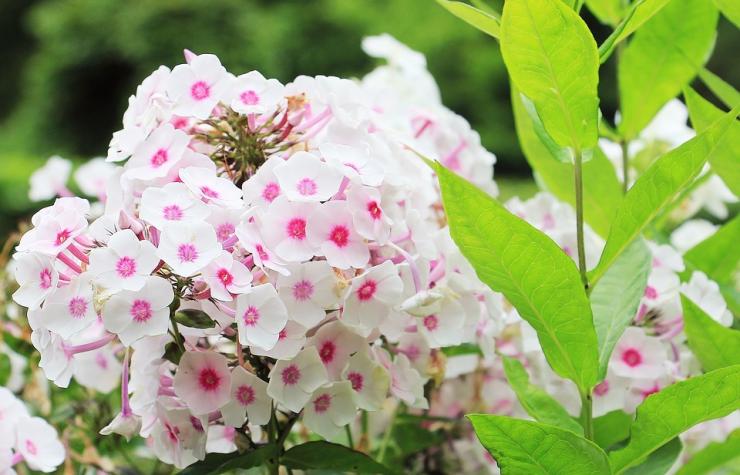

Landing dates
There are two short periods for transplanting seedlings into open ground. The first period, as you understand, is at the beginning of the season: usually the end of April, beginning of May. But most of our country at this time is still covered with snow. Therefore, the second period will be more suitable for Russia: from the beginning to the middle of September.
Selection of cuttings
Propagation by cuttings is a fairly simple way to grow seedlings. Cuttings can be purchased or made yourself if there is a suitable plant for this. It is worth buying cuttings either on the recommendation, or from a trusted seller, or in a specialized store - otherwise there is a chance of getting to an unscrupulous seller who has violated the conditions for caring for the cuttings and sells them already infected with fungi.
Landing rules
Rules:
- If a few days before the transplant there was dry weather and the earth had time to dry, then instead of digging it up, it is necessary to water it abundantly and loosen it with a cultivator to a depth of about 15 cm.
- Planting scheme in rows. The distance between rows should be about 70cm, and between plants in a row about 40cm.
- In some cases, seedlings are arranged in clumps of no more than 6 seedlings per square meter.
Do I need to trim phlox
The answer is unequivocal - yes. Phloxes must be pruned for the winter. Some of the reasons are:
- In order to improve the health of the plant, because over the summer it "collects" on itself pests, infections, larvae. All of the above does not die in winter and makes itself felt in the next season. When cutting and burning stems, the risk of spreading diseases and pests is reduced significantly.
- To facilitate treatment with drugs, preparation procedures for winter and so that dry growth does not prevent young shoots from developing in spring.
- For strengthening the root system and accumulating nutrients for the next generations of the plant.
- To prevent freezing. Since the roots are very close to the surface, they need to be covered, and uncut bushes will not allow you to do this efficiently.
- To improve the appearance: old dry branches next to young shoots do not add aesthetics.
Phlox should be pruned in the fall, not in the spring. The procedure is performed after the bushes have faded and before the onset of frost. Depending on the variety, pruning times differ - from the third decade of September to the end of October.
Cropping is done in several ways:
- low - the stump remains no higher than 2 cm;
- medium pruning - hemp height up to 10 cm;
- high - up to 20 cm.
The adherents of pruning underground motivate it by the fact that the potential danger of infection of young shoots is removed along with the stem. Fans of tall hemp say they hold snow better and absorb moisture.
Phlox after winter: care in spring
In the spring after winter, phloxes (subulate, paniculate) need some care. Phlox after winter in spring often looks unattractive and needs our help to restore decorativeness.
- A very important role in the care of phlox in spring is played by top dressing (the first of five for the entire season).
FEEDING. In the spring, after the snow melts (late March-early April) phlox are watered with a weak solution of humate or complex granular fertilizer.
This feeding allows you to accelerate the growth and development of the phlox root system after winter.
MULCHING. Simultaneously with top dressing in the spring, it is recommended to loosen the soil and mulch with fertile soil.
In the absence of soil, you can use compost, in extreme cases, sprinkle chopped grass with a layer of 3-4 cm, and a little sand on top.
CUTTING. In the spring, only dry shoots are cut off from phloxes (!). Pruning phlox in spring to give a supposedly more decorative appearance often results in a lack of flowering.
Indeed, after winter, phloxes have unattractive shoots with green chanterelles only at the tips, but it is better to feed and mulch.
- A full haircut of phlox can be done only after flowering (in summer), when flower buds are laid and young shoots grow. Then they cut on the tops and cut off the faded peduncles.
INTERESTING ON TOPIC:
Now you know how to prepare phlox for winter and how to care for spring after winter, and you don't have to worry about their condition.
We wish you beautiful phloxes and great mood!
Preparing phlox for winter
Before the onset of persistent frosts, cut phloxes are prepared for the winter period. This process is not complicated and does not require special preparation. A 2 / 3-1 bucket of rotted manure, compost, humus mixed with earth is poured near the bush. The mixture should completely cover the roots of the plant. Horse manure is considered the best mulch. For high-quality snow retention in regions with little snow, the cut phlox bush is covered with spruce branches, brushwood, and large tops.
Recommended!
If you find an error, please select a piece of text and press Ctrl + Enter.
Popular varieties
All phloxes are a unique culture, with their own characteristics and character. But, as always happens, some species are more loved by gardeners than others. For example: red wings, petticoats, blue dreams, and albatrosses.
Red Wings
Want a large flower bed dotted with vibrant pink flowers? Red wings are perfect for this! Bushes no more than 20 cm high, not whimsical and requiring no special care, not only calmly tolerate heat and cold snaps, but also bloom twice a season: at the beginning of summer and at the beginning of autumn.
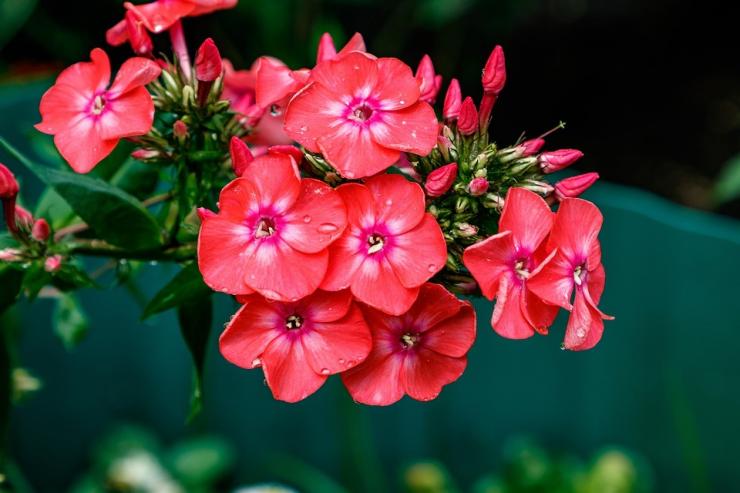

Petticoat
Five white Y-shaped petals form the flowers of this interesting variety. Petticoats calmly survive cold snaps and grow in soil, mainly consisting of sand and pebbles. This feature of them can help out the gardener when there are no other options to plant, something is not observed in such infertile soil.
Blue dreams
The small, tidy and very frequent light blue flowers of this undersized variety can cover both sunny and shaded areas of your garden like a carpet. The main flowering time is early in the season.
Albatross
Don't want to mess with sick flowers? Although this variety does not guarantee complete disposal of such a probability, it is much more resistant to diseases than its brothers in the family. In addition, the albatross has beautiful white, pink and bluish inflorescences with a diameter of about 4 cm. And also, easily tolerates heat and cold snaps.
Diseases and treatment
In spring, phloxes are affected by diseases and pests of flowering plants, as a result, their decorative effect deteriorates. Often the reason is poor-quality fertilizers and planting material, placement in partial shade. Flowers get sick: phomosis, leaf spot, powdery mildew, phlox nematode. This is especially evident in the spring-summer season with low temperatures and high humidity in June and July.
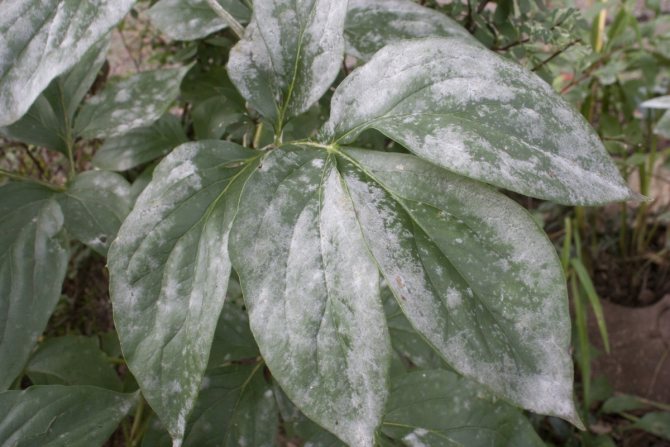

Photo:
The most common is powdery mildew, which looks like spider webs that attack the leaves. The disease begins to spread from the soil and eventually affects the entire flowering bush. As soon as the lesions are revealed, they must be cut off. Such systemic protection gives the desired result.
However, if you delay the treatment, the diseased plant infects others, which eventually die, so it is important to treat not only the bushes with fungicides, but also the ground around, this will contribute to the treatment and the restoration of decorative properties. On a plant infected with a nematode, the leaves become thin, ribbon-like, it is better to remove such a plant along with the roots.
After that, you need to withstand a certain period - 3 years. Phloxes and perennial flowers of this family cannot be planted on such a flower garden.
Every year in October, the soil is treated with fungicides that kill disease-causing spores. It is also important to do this in the spring, when the spores are awakening.
Common mistakes when growing
Despite the fact that phlox are not exotic plants, the following problems arise:
- high humidity attracts slugs, which devour plantings. The fight is reduced to the application of lime and wood ash around the bushes, which destroy the slugs;
- planting in an inappropriate location, strong shade or wetland. In the first case, the bush blooms poorly. In the second, the rhizomes rot and die;
- excess mineral fertilizers or manure application. The plant "fattens", builds up a huge mass of leaves and refuses to bloom;
- deep planting of the rhizome also postpones the flowering period;
- untimely plant transplantation provokes oppression of the plant;
- having bought planting material not in a specialized store, you can bring pathogenic fungal diseases to the site.
Correct planting of perennial phlox, selection and preparation of the site, healthy planting material, adherence to planting, care, watering, feeding technologies guarantee abundant flowering, which will decorate the garden, plot and delight the owners.
Should you cover your roses
Peony care 5 secrets of lush bloom
Not every type of rose requires insulation. No need for shelter:
- vintage garden roses;
- all species of rose shrubs, with the exception of Chinese, Bourbon and tea.
These plants are capable of surviving the harshest winters. Since such roses bloom once, their growth stops early, the wood of the shoots has time to fully ripen before the cold weather. With the arrival of winter, the shrub is ready for frost. The situation with modern garden roses is different. Such flowers were created specifically to delight their owners with lush and abundant flowering for a longer time, up to cold weather.
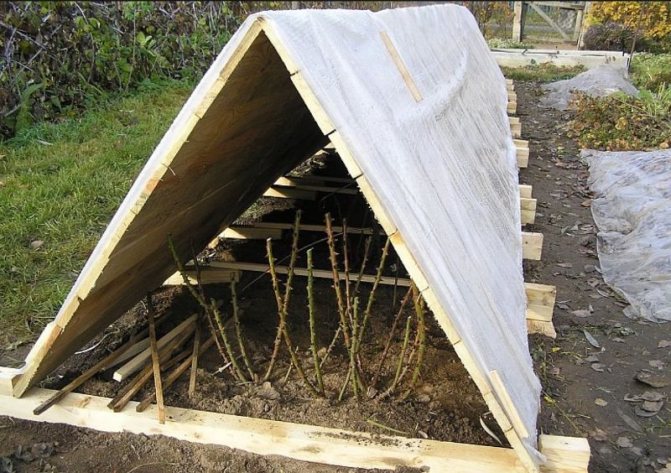

With the arrival of winter, the shrub is ready for frost
Garden types of roses are characterized by a long growth of shoots, which simply do not have time to ripen before frost
In this case, it is important to remember that almost all modern decorative varieties of roses require special care in anticipation of winter and need to be insulated. It is worth considering that shrub species (shrubs) are the most resistant to cold weather, but it is also advisable to close them for the winter from bad weather.
An exception among modern shrub roses is the wrinkled rose hybrids, since they are characterized by early flowering, and the second time they do not bloom very abundantly.
Benefits
For most plants, autumn planting has noticeable advantages over spring planting, and phlox is no exception.
- In autumn, more time for rooting is 30-40 days. In the spring, you can only count on a couple of weeks.
- Plants planted in autumn will bloom next summer. Spring breeding will not allow flowers to be seen in the first year.
- Autumn rains are enough for rooting, there is no need for abundant additional watering.
Plants planted in autumn will bloom next summer
Where and when to plant
Even a beginner gardener can easily achieve abundant and long-lasting flowering of phloxes - it is enough to plant a plant in a well-lit place a short distance from shrubs and trees. You can place phlox in a small shade, but be prepared for flowering later.
Planting dates depend on the variety of phlox.Instances with an early and medium flowering period for reproduction begin to prepare in August. By this time, the renewal buds of the plant are formed, and after transplantation it will not die. Late flowering phloxes should be planted in the second half of September - not earlier.
Even a novice gardener can achieve abundant and long-lasting flowering of phlox
Botanical description of flowers
Most of all known varieties are perennials. The following parts are distinguished in the structure of a flower:


Stems. Erect, ascending or creeping.- Leaves. They are located opposite on the stem, have a rounded-oval or more elongated (lanceolate) shape.
- Flowers. Small, funnel-shaped with 5 petals. Form complex inflorescences, which can contain up to 90 flowers. Their color varies from pure white, pastel to brighter scarlet and purple-violet shades.
- Seeds. Small, shiny, dark in color. Localized in fruits that look like an oval box.
Features of planting in the fall
When to plant perennial phlox? Phlox are perennials that bloom luxuriantly for several years, but over the years the flowers become smaller, and the bush requires rejuvenation or transplantation. Many gardeners like to experiment and change the appearance of the site in the spring or fall. But at the end of summer, new ideas arise: what to change, what plants and colors to add. Therefore, phlox transplantation is organized to another place.
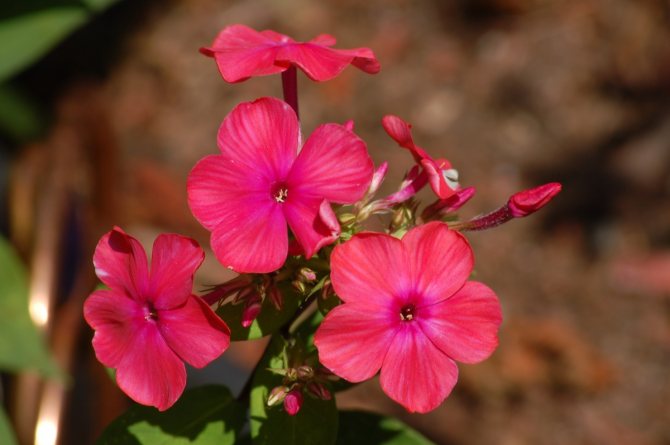

Despite the fact that this is a rather unpretentious flower, planting phlox in the fall has its own characteristics and some advantages:
Features of autumn planting
Despite their unpretentiousness, phloxes prefer fertile soil for planting. If the land on the site is poor, you need to properly mix the planting pit. We recommend the following proportions:
We fill the resulting mixture with mineral fertilizers and bring the acidity to the level of 6.5 pH. To do this, add 1 handful of furnace ash, superphosphate and lime to the resulting substrate. Then gently mix everything and pour the nutrient mixture into the planting pit.
On the left is ‘Koster’ phlox, and ‘Andreyka’ on the right. Photo of the nursery "Gardens of the Ural"
We recommend planting a phlox seedling at an angle of 50-60 ° to the soil surface and so that the upper buds remain above the level of the planting pit, and the lower ones - at a depth of 5-6 or even 8 cm. This technique is necessary in case of a severe winter. The hidden lower buds guarantee us that the seedling will not die, and the plant's regeneration will definitely take place.
After the phlox is planted, the soil should be gently trampled so that excess air comes out. Then we water. You will need at least 5 liters of water per division. After planting, the flowers, if they were on the seedling, should be cut off so that the root system is not distracted and it can take root well. In addition, such pruning will increase the number of future shoots, which means that the flowering of the bush will be more magnificent.
Phlox variety ‘Mary’ (another name ‘Miss Mary’). Photo of the nursery "Gardens of the Ural"
The subtleties of the autumn planting of phlox
The phlox fashion is experiencing a new upsurge, this is a global trend. Gardeners and landscape designers today prefer crops that do not require scrupulous care and increased attention. Phloxes meet these requirements in the best possible way. These are unpretentious winter-hardy plants with a high decorative effect.
Phlox are unpretentious winter-hardy plants with a high decorative effect. Photo of the nursery "Gardens of the Ural"
The phlox bloom period lasts from late June to September. To spend the whole summer in their company, it is not enough to choose the right varieties. You need to plant the seedlings at the right time. In the nursery "Sady Urala" choose an autumn planting.Why this is the best time for phlox and how to properly plant seedlings of this culture in the fall, we will tell in this article.
About the nursery "Gardens of the Ural"
The assortment of our nursery has no analogues in the whole horticultural world. We do not purchase imported material for the purpose of resale. Our catalog contains only our own seedlings, which we grow with the help of modern approaches and technologies, observing competent agricultural techniques. In particular, we use drip irrigation systems and fogging installations, which allow us to create tropical conditions even in the harsh Urals.
The assortment of our nursery has no analogues in the whole horticultural world. Photo of the nursery "Gardens of the Ural"
In the autumn catalog, you will find more than 450 species and varieties of fruit and ornamental plants, including Canadian irgu and Canadian honeysuckle, Meyer's lilac, 'Mavra' bird cherry, as well as 24 varieties of phlox. You can place an order according to the autumn catalog until August 1, 2019 on the site of the Ural Gardens nursery. Renewing your collection and planning the next season in the fall is a smart decision. It is the autumn plantings that give the highest survival rates - not less than 90%.
The main secret of success is the work and love of our employees. Photo of the nursery "Gardens of the Ural"
For 35 years of work, we have developed our own "formula for an ideal seedling", which has taken root and took root for the next centuries throughout Russia. But the main secret of success is the work and love of our employees. Only the attention and care of a person allows you to grow a tree with a century-old history from a small seedling or create a lush garden to the delight of people.
Alexandra Miroleeva, head of the nursery "Sady Urala"
Site selection
The abundance and duration of flowering depends on the level of illumination. Different groups of phlox have different lighting requirements. Bush forms are suitable for sunny or slightly shaded areas; for tall bushes with bright flowers, an area with diffused light is the best option.
The climate plays a role in choosing a place - in warm regions, a cool area with little shading is preferable so that the soil does not overheat; in regions with cold winters, you need to choose a place protected from through winds and well lit most of the day. In a windy area, the bush falls apart, becomes sloppy.


Most species (varieties) of creeping and loose-baked phlox are suitable for sunny areas - in a shaded place the carpet will not be as bright and dense as in the sun. Open areas, blown by the wind, are not scary for them. But when choosing a variety, it is necessary to pay attention to its characteristics so as not to be mistaken with the place - some varieties, for example, the splayed phlox, will delight with bright flowering and in partial shade.
It is not recommended to plant phlox next to evergreen, coniferous, deciduous crops, the roots of which are located superficially (for example, willow, lilac).
If we talk about the relief, then you can use both a flat surface and a small slope - the main thing is that there is no stagnation of moisture. When planting perennial phloxes near buildings, fences, you need to pay attention to the orientation of the object, its features are bush and some varieties of ground cover forms will not grow from the north side, where there is not enough light and cool.
Soil requirements
The approach to the composition of the soil should be individual, since each species has its own requirements - the growth and flowering of the same variety will differ in soil of different composition.
Shrub forms are most comfortable in loams, fertile, loose, with a pH of 5.5 to 7 soils, carpet ones like light sandy loam, loamy soils with a neutral pH, and clayey, dense, acidic soils are not suitable for them. If the groundwater is close or the melt water leaves slowly, then a drainage layer or high ridges, flower beds are needed.
Since bush varieties grow in nature on forest edges, meadows, in river floodplains, wet lands are preferable for them and loose sod forms in the garden area - in dry they will need to be watered often. Ground cover phlox tolerate drought well.
Any soil for planting perennial phlox is prepared in advance - in the previous season or 3-6 months in advance. The minimum time during which the soil is structured and settles is two weeks.
Preparation stages:
- free the site from weeds, roots, debris;
- dig up, adding sand (peat) to heavy soils, clay, peat, manure into sandy soils, at a pH of at least 5 - a glass of ash per bush, into sour soils - lime (lime in an amount of 300-350 g / m² raises the pH per unit );
- build a drainage layer in too wet soils;
- fertilize with organic matter (compost, humus) - ½ bucket in each hole or 1.5-2 buckets per 1m², covering to a depth of no more than 20 cm, since the roots are located superficially;
- simultaneously add ash (100-150 g / m²), superphosphate (50-60 g / m²);
- if the soil is dug up in the fall, and planting occurs in the spring, then it must be dug again, compost, 50 g / m² of mineral fertilizers (superphosphates are used only in autumn).
Sawdust or shavings added with compost lead to a nitrogen deficiency in the soil, because cellulosic bacteria need it. In addition, pathogens of fungal infections are found on the sawdust.
Landing
When planting seedlings, it is important to observe the distance between them - the roots grow, they need free space. Slow and weak growing varieties can be planted at shorter intervals than indicated in the recommendations.
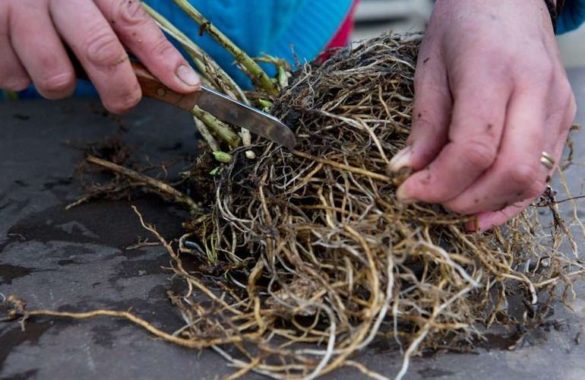

Sapling spacing:
- undersized, curb, loose sod species - 35-40 cm;
- carpet - 25-30 cm;
- medium-high - 50-55 cm;
- high - 60-70 cm.
Before planting, the roots are shortened to 15 cm, the stems are up to 5-15 cm, the sections are treated with coal powder or ash, then the root system is lowered into a growth stimulator for 2-3 hours. A small mound is poured into the hole a little more than a lump of earth, a seedling is installed, loose roots are straightened, covered with earth, slightly compacted, watered (1/2 bucket per bush). The root collar should be 3-5 cm below the soil level.
For better rooting, after three days, you can water with Kornevin (4 g / 1 l), spending ½ l for each seedling.
Choosing the right planting material
The key to future success is the correct choice of planting material, which can be of the following types:
- a seedling taken by dividing an adult bush;
- grown as a result of sowing maternal seeds;
- purchased from a specialized location.
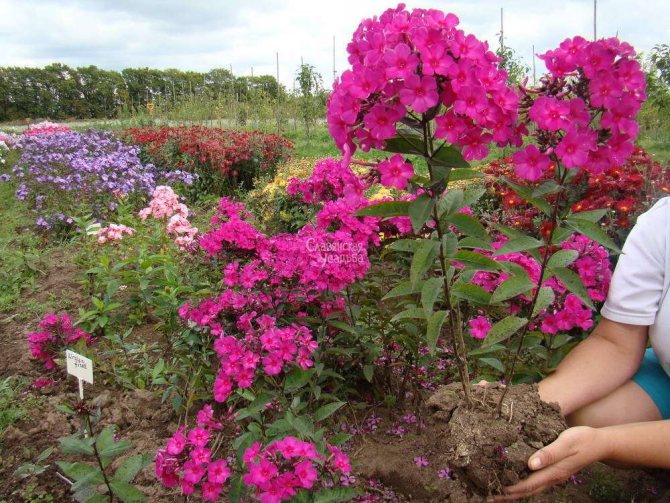

For planting, mature plants are suitable, which are characterized by a coarse greenish skin. The seedling must have at least two stems, at the bases of which full-fledged buds have formed. Its leaves are green, strong, not damaged by anything. The root system is also healthy, it is shortened to 15 cm, and the stems are cut at a height of 10 cm. Anything that does not fit this description is not suitable for planting. I must say that the best planting material, according to many gardeners, is obtained by dividing biennial plants.
Choosing the right place for planting and soil
Perennial phlox grow well in loose, loamy soil. The question immediately arises, what kind of soil do phloxes like acidic or alkaline? Rather, neither one nor the other, but something in between, with neutral acidity. The soil must have the ability to pass air, the presence of groundwater at a close distance from the plant is undesirable, since excessive moisture can lead to rotting of the roots and their further death. If the soil for perennial phlox is not too nutritious, it must be supplemented with humus, compost and mineral dressings. If it is too clayey, sand and peat will not interfere.
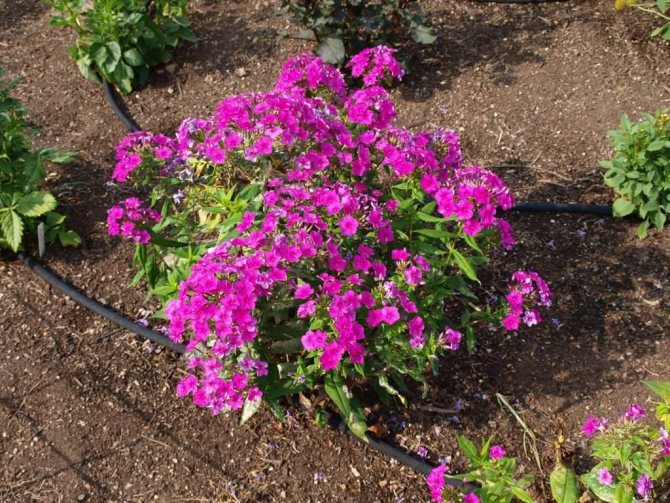

Where to plant phlox? The choice of location should be considered. Spontaneity often does not lead to success.It is best to start preparing the location in advance - 2-3 weeks before the future planting. Beginners often wonder where to plant phlox, in the shade or in the sun. Answer: in partial shade. A slightly shaded area with little direct sunlight is ideal. In the place you like, you need to dig up the ground so that there is no hardness, but only small lumps. The depth is shallow - a shovel will be enough for a bayonet.
Removing excess foliage
This seemingly superfluous at first glance artificial measure, firstly, is determined by the need to prepare plants for a state of seasonal dormancy. Secondly, it is a sanitary measure against the appearance in the mass of not completely fallen leaves of a favorable environment for rot and the development of harmful microbes and fungi. Thirdly, in the autumn crown of the rose there are already many leaves damaged by black spot or other infections.
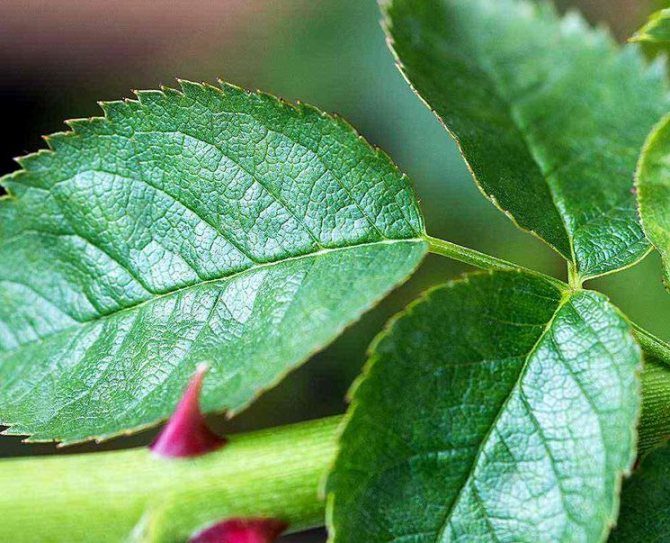

By cutting off excess and defective leaves, we prevent future seasonal problems associated with common rose diseases, and we make the process of wintering under cover safe and successful. Dispose of cut leaves by burning, giving no chance of spreading spores, microbes and viruses in the next season or significantly reducing their impact.
It's important to know! In no case should you pick off excess leaves, which leads to injury to future buds and shoots, but cut off with a clean and very sharp secateurs or scissors, for convenience, folding them into the trash can immediately. It is imperative to cut off underdeveloped inflorescences and fruits, thereby excluding their rotting under cover
If you have several bushes, and among them are climbing or a whole rose garden, then such a preparation measure becomes too burdensome and almost impossible to do.
Here it is important to distribute forces and not to postpone the pruning of leaves for one pass, starting from September to do this sanitary pruning in a dosage manner. If it is not possible to cut off all the leaves in full under the conditions of your rose garden, then you must first of all limit yourself to cutting out defective or diseased leaves
Spray those leaves that you do not have time to cut with Bordeaux liquid, copper or iron vitriol, as well as the Maxim fungicide. Treat the soil around the bushes with ash.
Soil preparation
Planting phlox and landscaping begins with the selection of a site, which is prepared in advance, about a couple of weeks before the planned planting. It must be dug up so that the earth has time to settle, and the flowerbed does not turn out to be buried in comparison with the rest of the site.
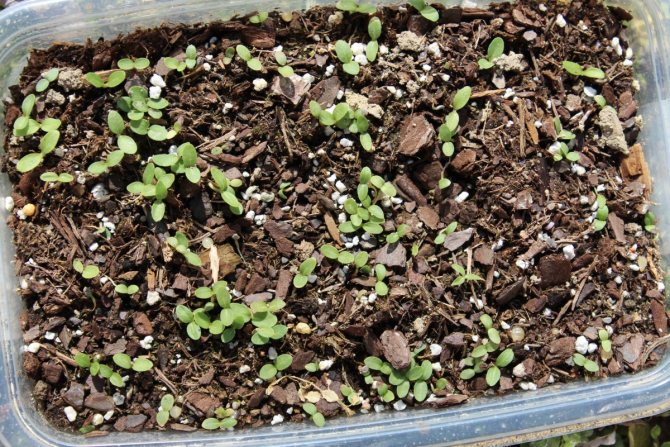

Photo:
It is necessary to dig the site to a depth of at least 35 cm, since the rhizome is in the soil at a depth of 20 cm. Remove debris, plant roots, perennial weeds. To do this, use:
- compost;
- coarse river sand;
- ventilated peat;
- ripe humus (preferably made from leaves).
The approach to sandy soil is different. It is necessary to improve the structure, moisture capacity, make the soil nutritious; for this, clay, turf soil, lime or wood ash, and mineral fertilizers are added during the digging process.
Plant characteristics
In nature, about 85 species of culture grow, among which there are perennials and annuals, herbaceous and semi-shrubs. The area of greatest distribution is the territory of North America. In Russia, only wild Siberian Phlox (Phiox sibirica), which are creeping species, are found in nature.


The name of the genus (family Sinyukhovye) owes to K. Linnaeus, who described a wild plant, the flowers of which had a scarlet-red color - the word "phlox" (Phiox) in Greek means "flame".
Most of the representatives of the genus are semi-shrub herbaceous perennials, growing in height from 50 to 150 cm, but there are also creeping (ground cover) species from 15 to 20 cm in height. Oval-shaped opposite, elongated leaves are pointed at the tip.Some of the fibrous branching roots with a thickness of about 2-3 mm are located in the surface layers of the soil, some go 20-30 cm deep.
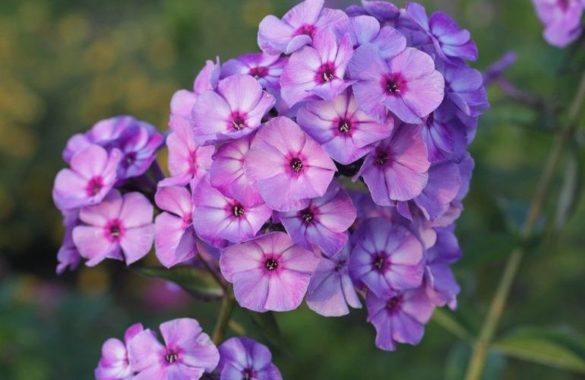

Small funnel-shaped flowers (2-4 cm in diameter) are collected in a complex inflorescence, the growth of which continues throughout the entire flowering period, reaching large sizes. It occurs due to the division of the lateral branches - each is divided 1-2 times, so the inflorescence takes on a spherical or cylindrical shape. Seeds are formed in an oval or round box.
Autumn watering and feeding phlox
Watering faded phloxes in the fall is carried out as needed - depending on the weather outside. Remember that for the winter, the plant should go well nourished, including moisture.
As for the fertilization of phlox in the fall, nitrogen-containing fertilizing should be stopped already in the middle of summer - otherwise the plant by the fall will begin to build up green mass that is unnecessary in the cold, which can simply freeze out.
In the middle of September, potassium-phosphorus feeding of phlox should be carried out - this will help them gain strength for the winter and strengthen their immunity. To do this, dissolve 20 g of potassium monophosphate in a bucket of water and spill the bushes at the rate of 10 liters per 2-3 adult plants.
To fertilize and disinfect, also dust the soil around the bushes with a thin layer of wood ash. Ash can be embedded in the soil, but shallow, so as not to damage the roots of phlox.
Planting process
Just before planting it is necessary to water the soil, and if the weather is warm, sunny, then it is very good to water. Several belts of plants are planted in the loosened soil. The intensity of their development depends on the distance at which phlox plants are planted, so the distance between seedlings should be at least 30 cm.If planting work is carried out for the sake of abundant landscaping of the territory, then the plants can be located denser, but no more than six bushes per 1 square meter.
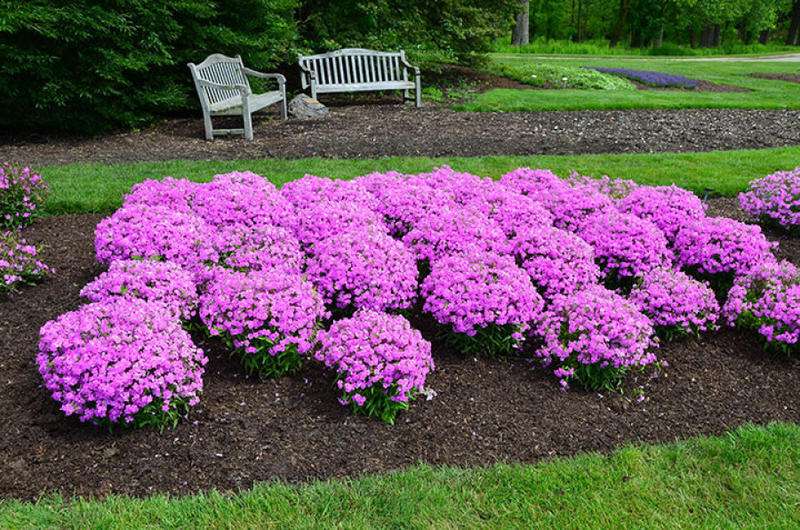

How to plant phlox roots? Carefully so as not to damage the root system, which must be carefully straightened when immersed in the hole. As for how deep to plant phlox, this aspect depends on the size of the seedling. It is necessary to ensure that the already formed vegetative buds are slightly lower than the topsoil, by about 5 cm. If they are immersed too low, they will develop poorly, if high, they will be negatively affected by low temperatures.


How to choose healthy planting material
For autumn cultivation, it is recommended to use large cuttings. They take root well and tolerate winter frosts more easily than their smaller counterparts.
Types of phlox
There are also popular varieties: Twilight, Karl Foster, Childhood, Smoky coral, Ural rocks, etc. The main parameters of the planting material:
- coarse stem skin;
- two thick, developed stems;
- large basal buds;
- lack of rot and mechanical damage;
- delenki with powerful roots.
How to cover roses for the winter
Non-lignified shoots have already been removed, strong shoots prepared for winter must be cut off so that they are completely covered, the leaves are removed. Spraying with Bordeaux liquid (3%) is carried out, it is also possible with another fungicide.
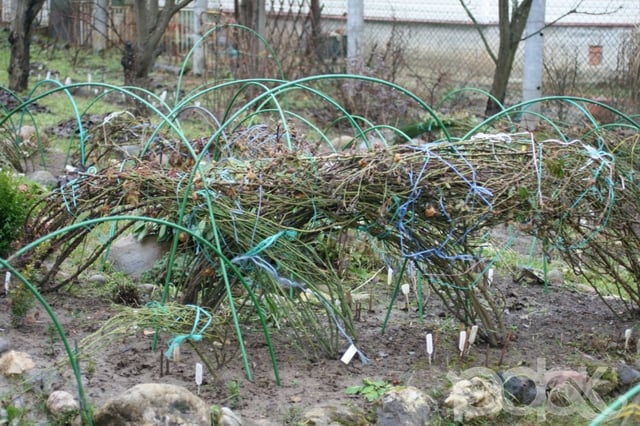

Preparing roses for winter
In October-November, you need to sprinkle the root collar of a rose bush with dry sand, per plant 0.5-1 l, after that 1-2 buckets of peat, dry leaves, compost or soil are poured onto the bush. Do not take soil near the bushes so as not to bare the roots, otherwise the plant will die.
If the covering material has not completely covered the rose bush, then spruce legs can be laid on top, and on top of them there is plastic wrap, lutrasil or spunbond, which can be pressed with stones. The lapnik will prevent the covering material from caking under the snow, and will also protect the bush from mice.
In the middle lane, preference is given to an air-dry shelter of rose bushes for the winter.Frames up to 50 cm high are constructed from wire or boards over rose bushes. Burlap or kraft paper is laid on the frames, and then plastic wrap. In this case, only the root neck of the rose bush is sprinkled with soil or sand.
Until the temperature drops to minus 7-10ºC, it is necessary to arrange ventilation slots.
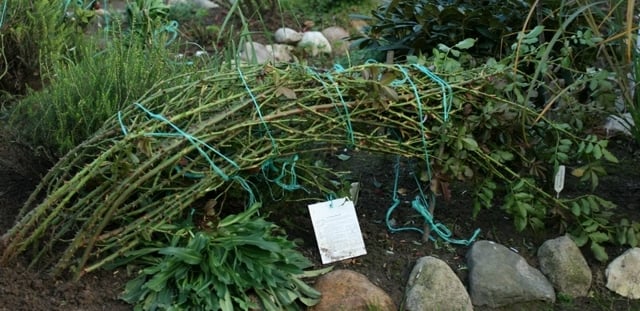

Shelter climbing roses for the winter
Tall roses are covered for the winter in a different way. The root collar is also covered with sand and then soil. Spraying with one of the fungicides is carried out, followed by drying. It is desirable to remove the leaves. Then the branches of roses (for example, climbing) are removed from the supports without cutting, and then they are laid on spruce branches, plywood or a wooden board laid on the ground.
The work will be easier if the shoots are tied with a rope in several places. Removal of the stems is carried out in late autumn until stable frosts. Cardboard, spruce branches and film lay on top of the shoots.
There is another way to hide climbing roses, in which you do not need to remove the stems from the supports. It is necessary to remove the leaves, tie the stems in several places, tie them with spruce branches, paper, and then burlap.
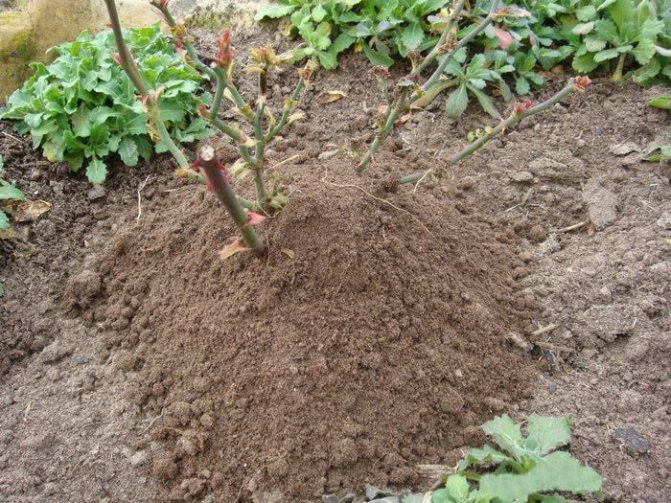

Shelter roses for the winter
Standard and semi-twisted varieties should be bent in several steps, pinning them each time. Then everything is done in the same way as with climbing ones.
Roses covered for the winter awaken earlier in the spring. Therefore, you need to free them from shelter in time.
An important point
Preparing roses for winter is especially needed for young bushes that live on the site for the first year. Covering them must be done carefully, without saving on materials.
It is not possible to name the exact dates for the shelter of roses, because it depends on the geographical location of the area and climate conditions. Not only cold can lead to the death of a rose, but also an early shelter, in which the buds are vomited, and the shoots become moldy
For a good wintering, it is important to stop the vegetation of the plant - stop the application of nitrogen by August and reduce watering
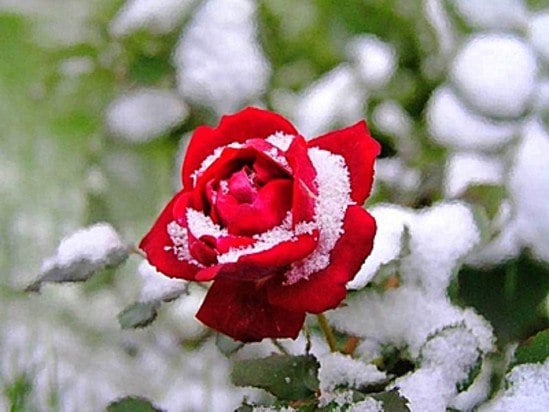

Frosts are not so terrible for roses as the alternation of thaws with them. Moisture trapped under the shelter turns into ice in frost, which can destroy the plant. And even in a humid environment, diseases develop well, therefore, the shelter of roses must be performed in dry weather, the shelter must be equipped so that water access to the roses is excluded.
Major mistakes
Below are the most common mistakes that are made during autumn phlox care. Timely familiarization with them will prevent possible repetition of them in the future:
- Adding large amounts of nitrogen to the soil. It can provoke unnecessary growth of root shoots and shoots in winter, which will take away a large amount of strength and accumulated nutrients from the plant and can lead to the death of phlox.
- Failure to comply with the terms of the organization of the insulation shelter. It should be installed only at the moment when thaws are no longer expected, but before the arrival of the first serious frosts.
- Adding individual components to the soil, necessary to create bait mixtures or liming the soil. All ingredients are mixed before being added to the soil and thoroughly mixed to obtain a homogeneous mass, otherwise there is a risk of root burns.
Interesting varieties of phlox for planting in the garden
It is noteworthy that phlox planting and care in the open field is incredibly simple, even for novice florists, and you can choose for yourself those varieties of phlox that you like.
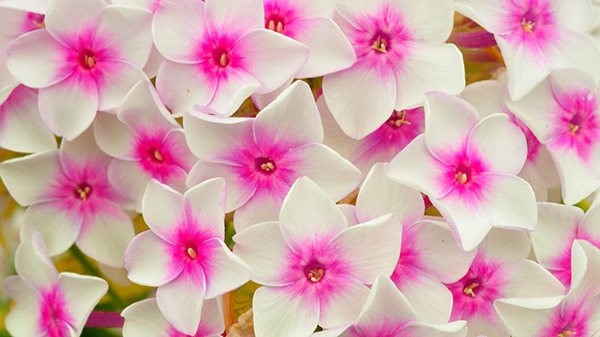

Breeders have developed a large number of varieties. Which are worthy to decorate a flower bed in every garden. It is worth noting that annual phloxes are represented by one species - Drummond. Within which there are many varieties:
- Star rain, growing up to 50 cm with flowers in the shape of stars;
- A twinkling star, a bush of which does not exceed 25 cm, blooms all summer;
- Constellation with bright flowers, the size of which reaches 3 cm in diameter;
- Promise Pink will grow into a bush up to 20 cm in height.
Most of the varieties on the market are perennial phloxes, which need to be pruned in the fall and transplanted every few years. Among them, one can single out those that are especially popular with gardeners or have a remarkable color:
- Baikonur with pale pink flowers that do not fade in the sun;
- Starfire striking with a dark red shade of inflorescences;
- Margarita decorates the flowerbed with crimson flowers with dark eyes in the center;
- Marshmallow with white flowers, decorated with pink dusting, fading in the sun;
- Strawberry soufflé - the salmon shade of the petals is accentuated by a purple ring in the center of the flower;
- Spread blue phlox, growing up to 30 cm;
- Douglas phlox refers to a ground cover plant, it grows up to 20 cm in height, and its branches spread around a distance of up to 25 cm;
- Fiona in the sun has light lilac shades, and in cloudy weather and in the evenings, the flowers turn blue.
Reproduction of phlox
Pruning pears in the fall - how to prune correctly
Varietal phloxes can be propagated by dividing bushes, stem and leaf cuttings, spring shoots, summer-autumn axillary shoots, root cuttings.
Phlox bushes are divided in early spring or early autumn (at this time, the bushes should be divided into larger parts). The dug out bush must be shaken off or washed from the ground and separated by hands: first, precisely separate the plexus of the root necks, then disassemble the roots going to them. The knife should be used only when it is not possible to divide the rhizome with your hands, and you only need to cut it with a knife where the root necks grow together. Each separated part should have growth buds - “eyes” or shoot rudiments and a small number of roots.
Reproduction of phlox by stem cuttings can be carried out from the end of May to the 2nd half of July. For cuttings, take green, well-developed stems from healthy plants. Each stalk should have 2 knots, with the bottom cut just below the bottom knot, and the top one 5-10 cm above the top knot. Cut off the lower leaves completely, keeping the axillary buds. Plant the cuttings in shade, deepening them into the soil approximately to the upper node. For the first week, cuttings should be watered with warm water several times a day, making sure that they do not wither.
When propagated by leaf cuttings, an axillary bud with a leaf is used. In the summer, during the period of full development of the phlox stems, a shield 8-10 cm long with an axillary bud and a leaf is cut from their middle part with a sharp knife or razor. When planting, the flap must be placed vertically, deepening the axillary bud by 1.5 cm, cut off large leaves by 1/3. The plantings should be sprayed with warm water and the boxes should be covered with glass, placed in a room with a temperature of 25 ... 30 ° C. The sand must be constantly wet. By autumn, a plant with one stem is formed from a leafy cutting. For the winter, it is recommended to put boxes in a cold greenhouse, insulating it from above. In the spring of next year, rooted cuttings can be planted in open ground.
Reproduction of phlox by spring growth shoots - a type of propagation by stem cuttings
Growth shoots can be taken from heavily thickened bushes, carefully breaking them out at the very base with a "heel". For better rooting, shoots should be planted in a warm greenhouse or greenhouse - in the open field they do not take root for a long time
You need to water it with warm water. In the second half of May and early June, rooted shoots can be planted in open ground.
Summer-autumn axillary shoots propagate phlox in the same way as spring growth shoots. It is necessary to use shoots growing in the leaf axils.
For this, non-lignified, healthy, thick and long roots are suitable. They need to be cut off at the very base of the rhizome, cut into pieces 3-5 cm long and planted obliquely in exploration boxes filled with nutritious soil.First, the boxes should be placed in a room with a temperature of 10 ... 15 ° C, after 10-15 days they should be rearranged to another room with a temperature of 18-25 ° C and kept in shade.
When the shoots appear, the shading must be removed and the plants must be gradually accustomed to light, and then transplanted into open ground. Sprouts do not appear on all root cuttings, and they develop unevenly, therefore, plants should be planted in open ground selectively, as the sprouts grow. This method of propagation is especially valuable when the plants are infected with stem nematode and it is necessary to preserve the variety.

